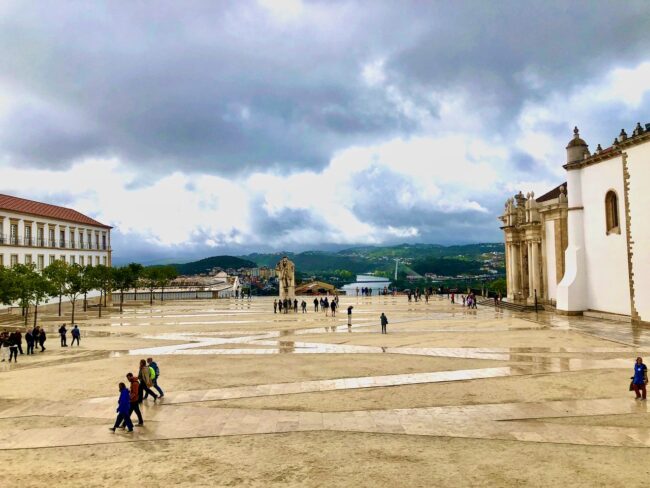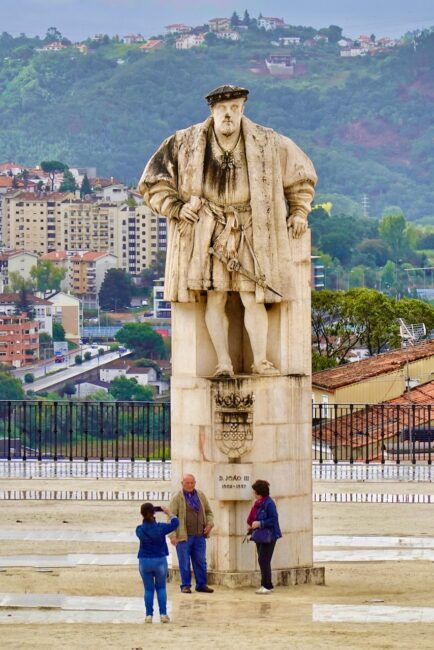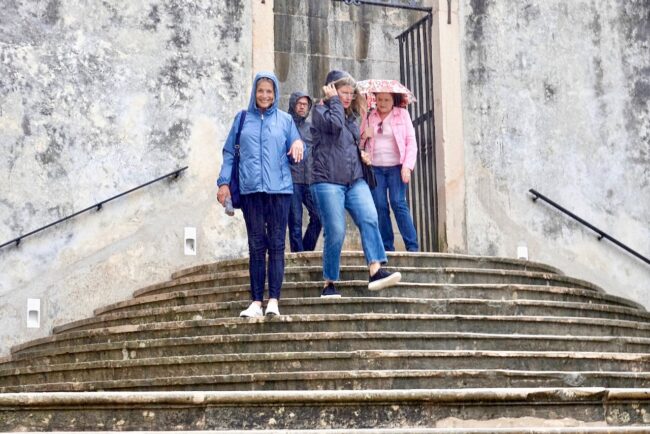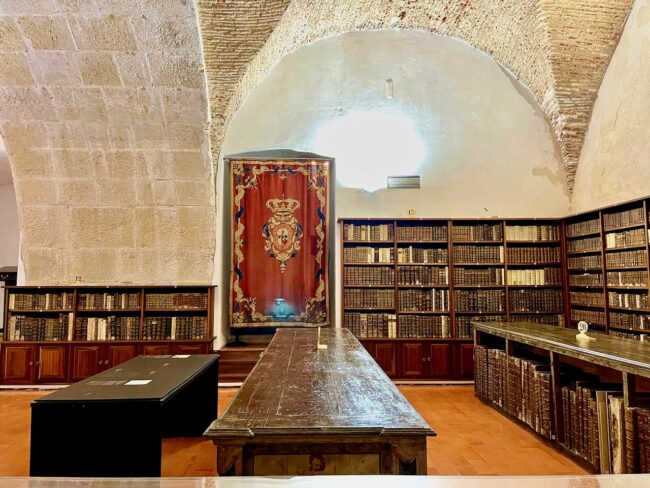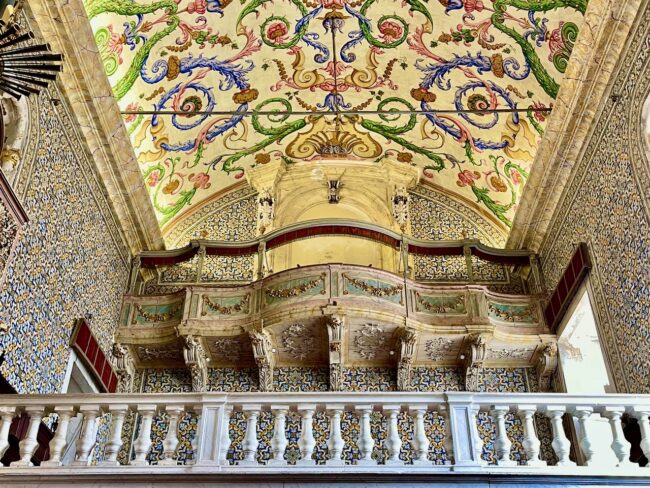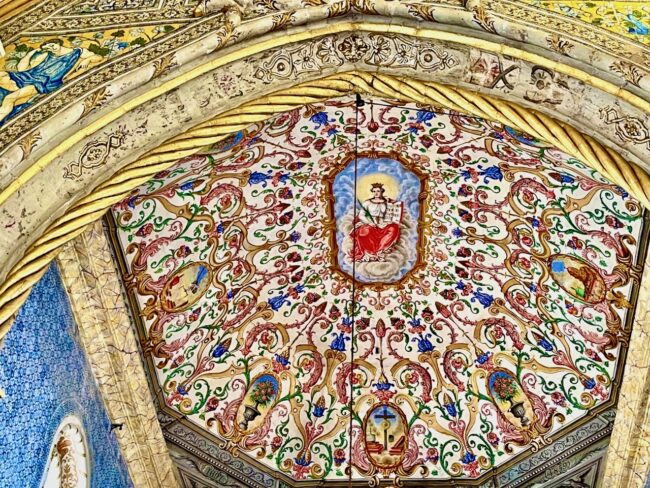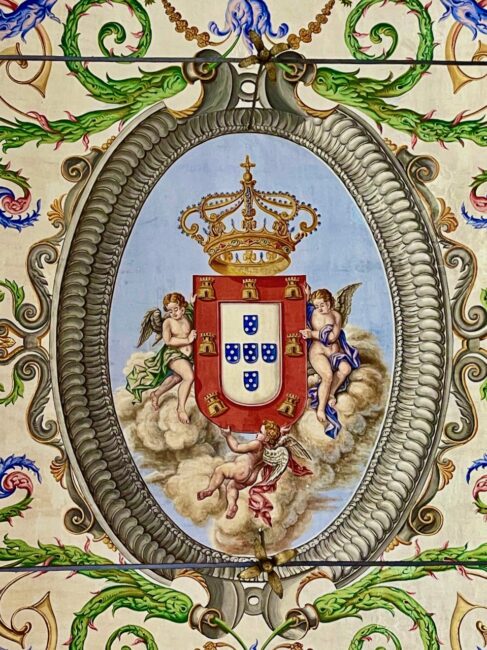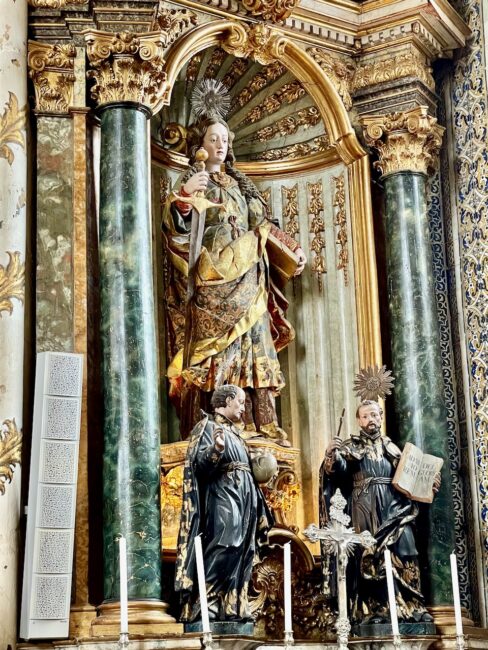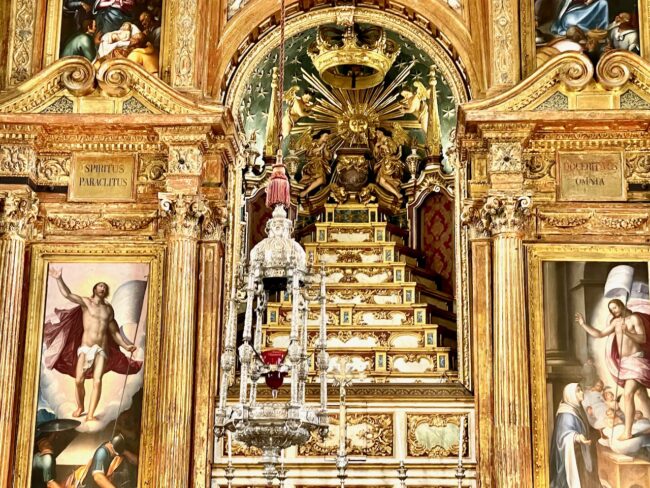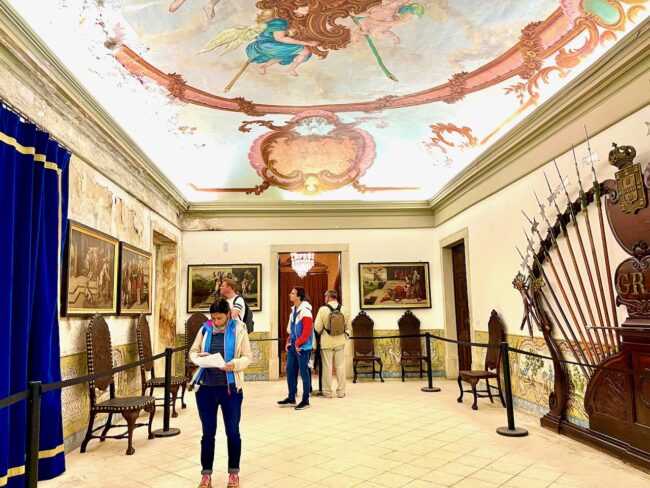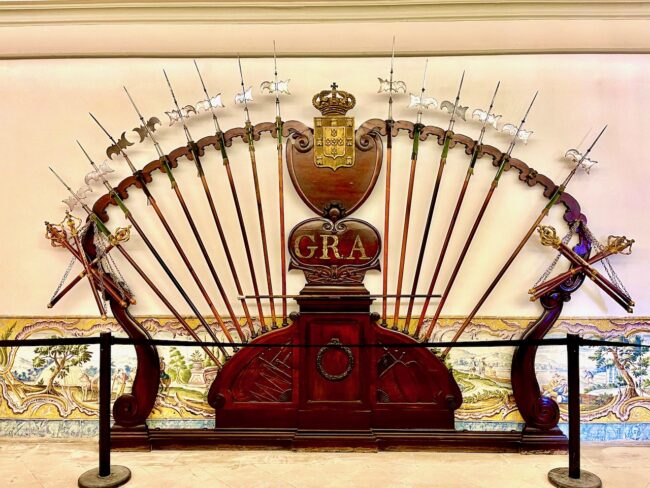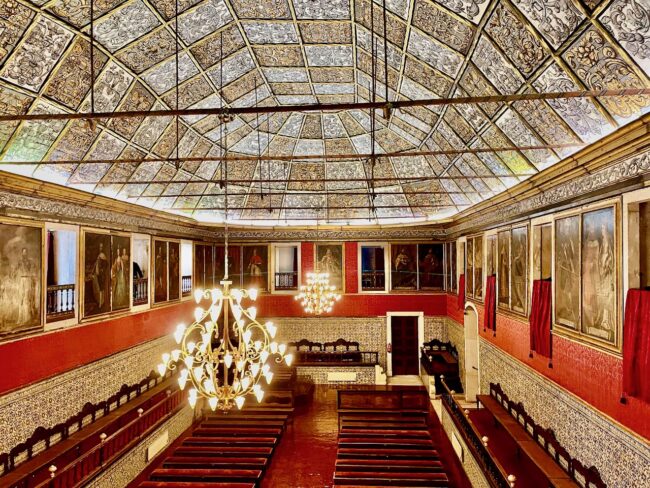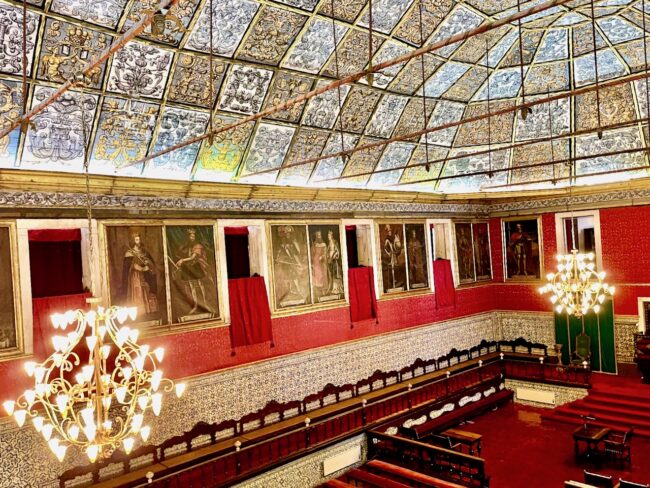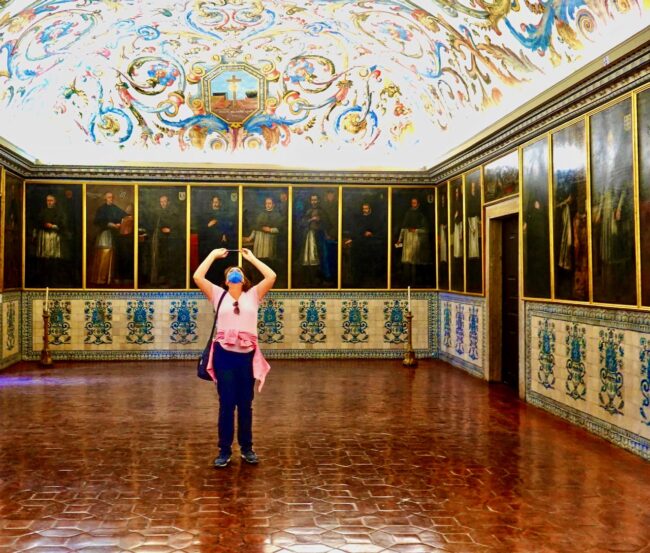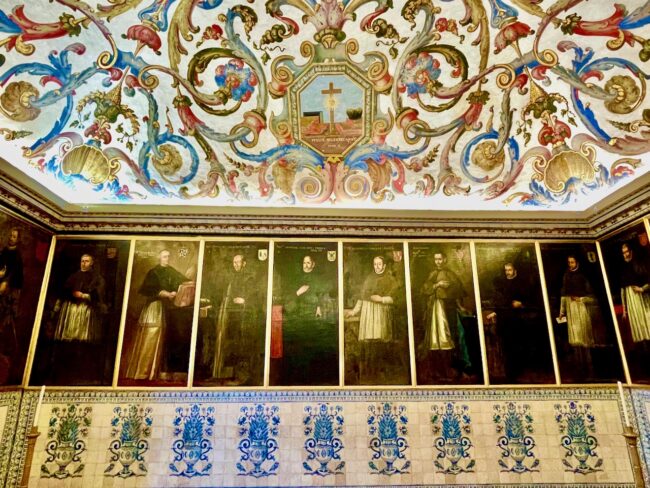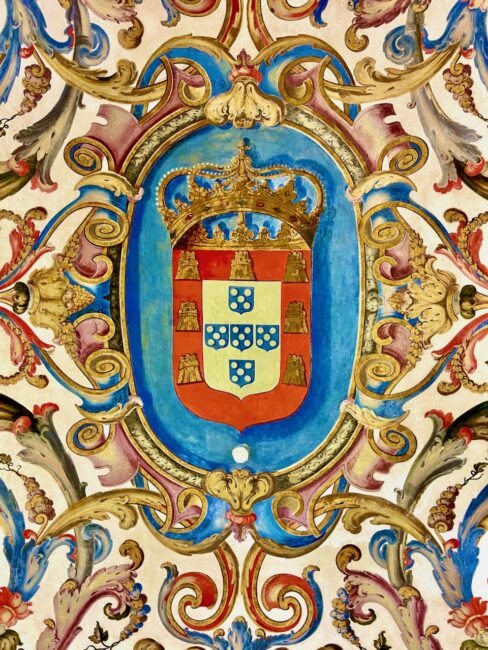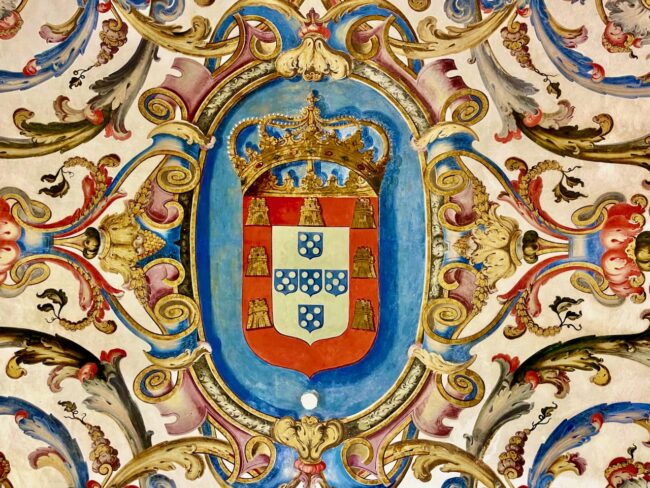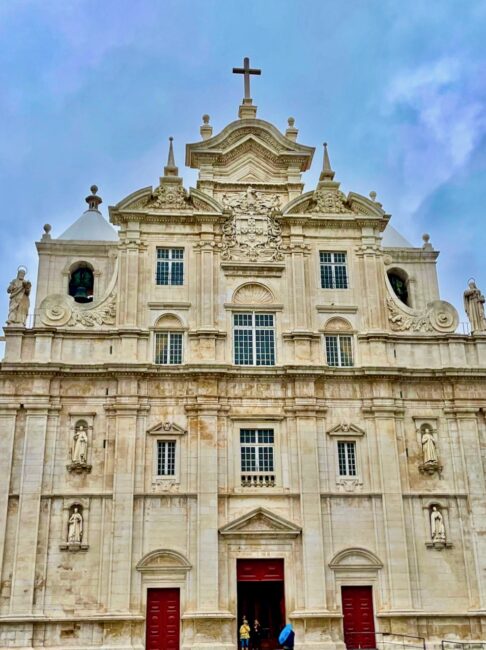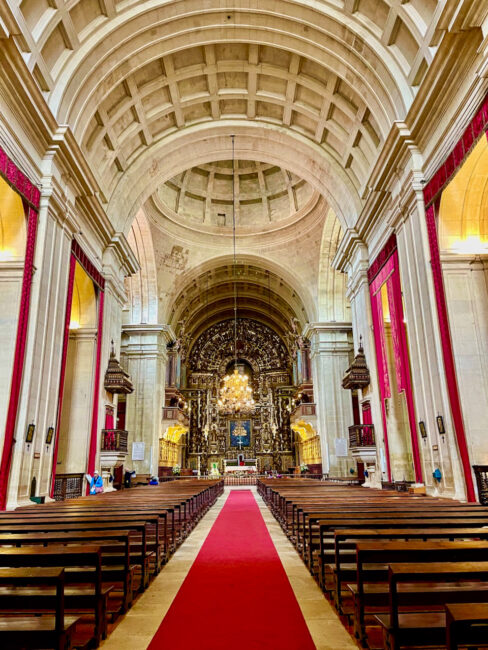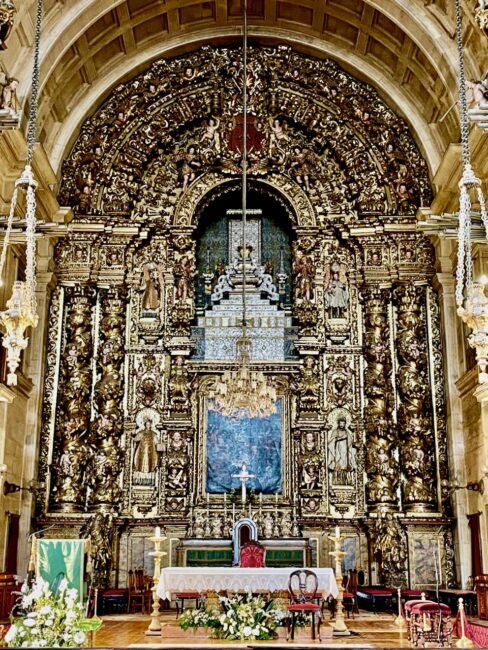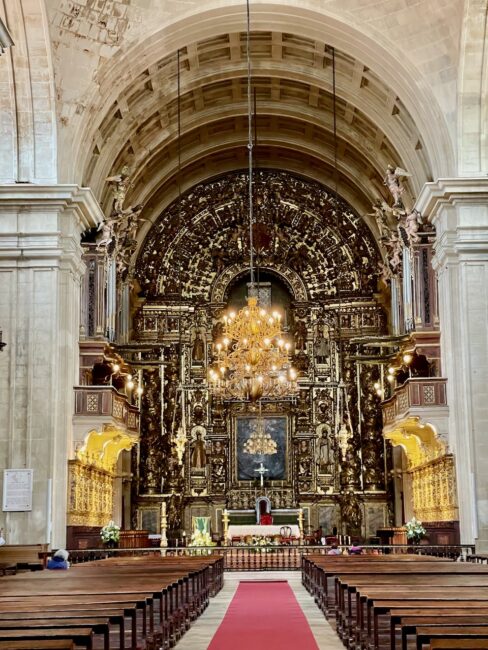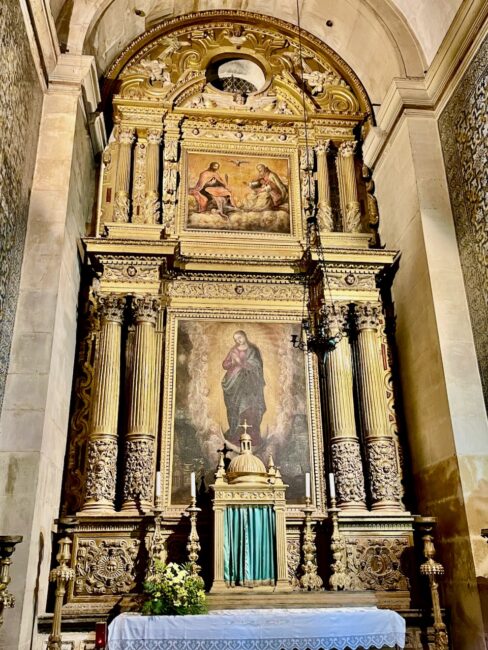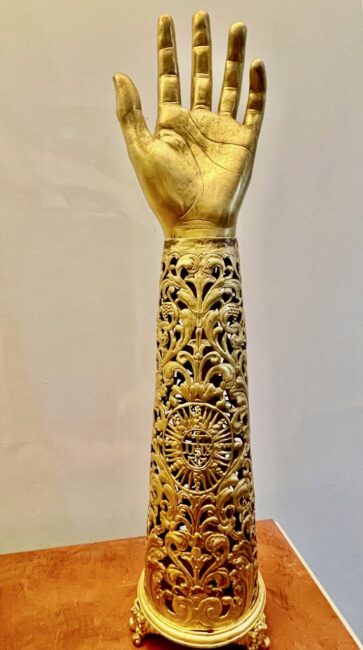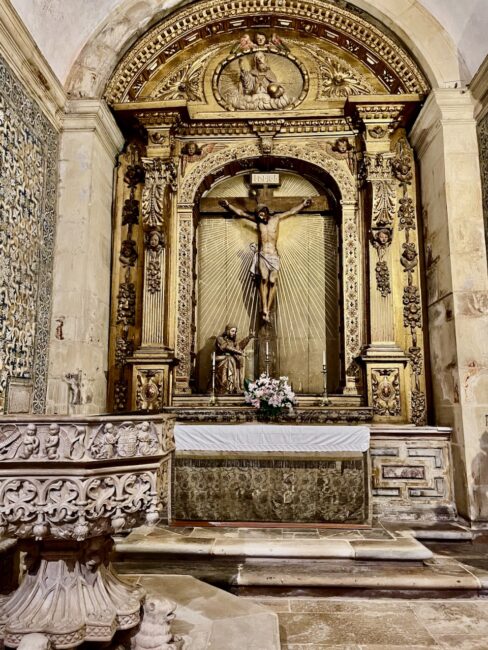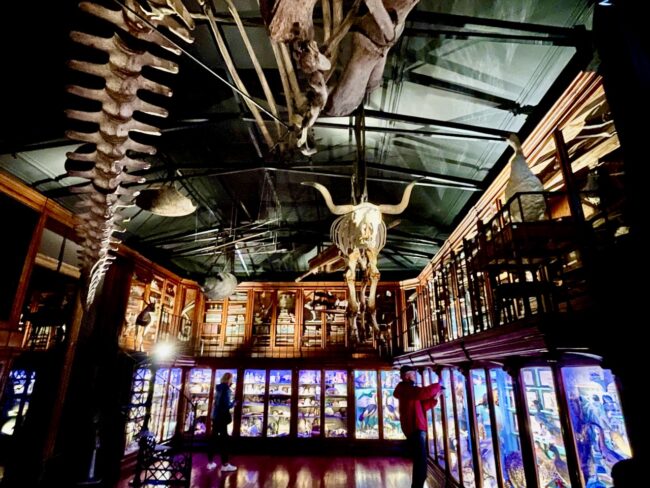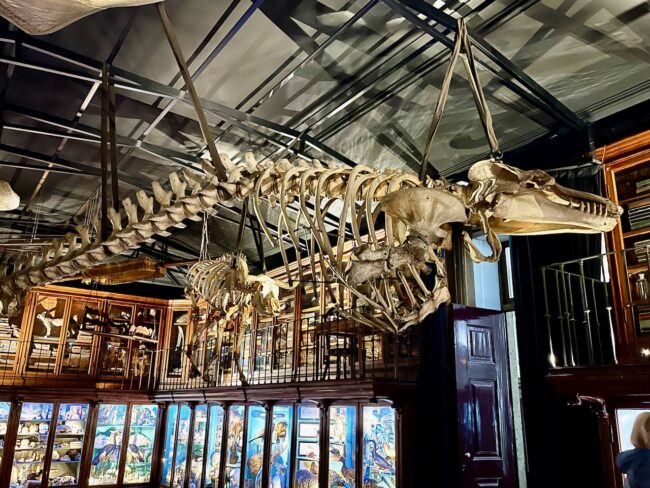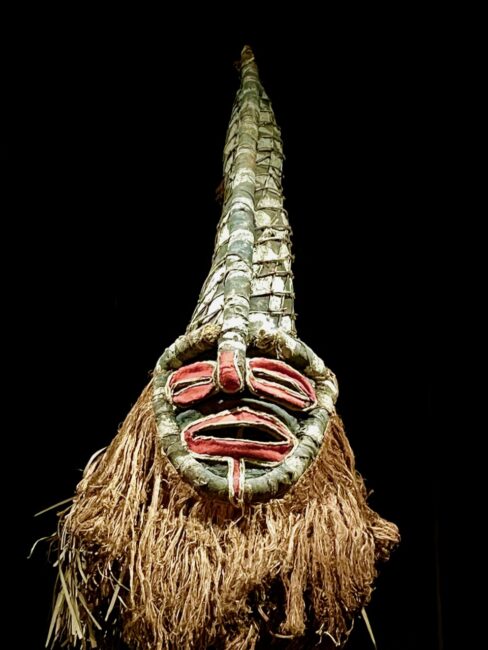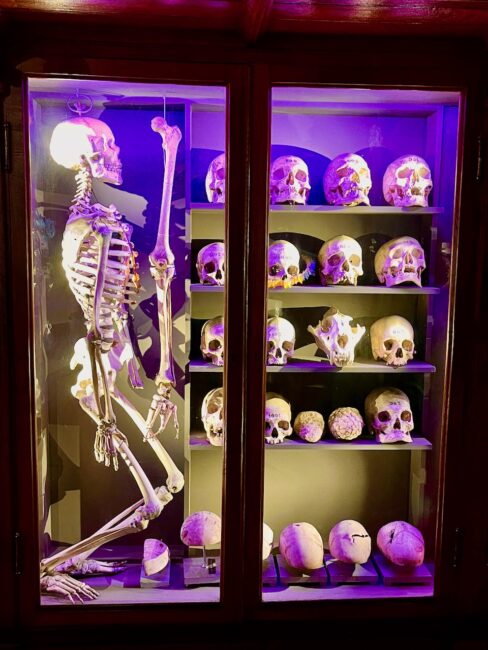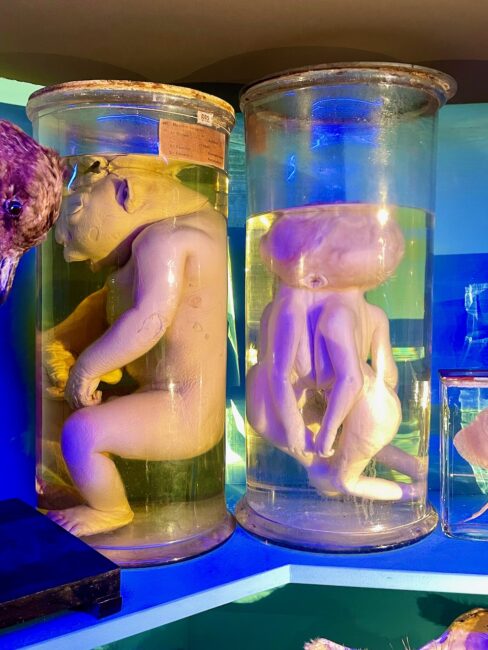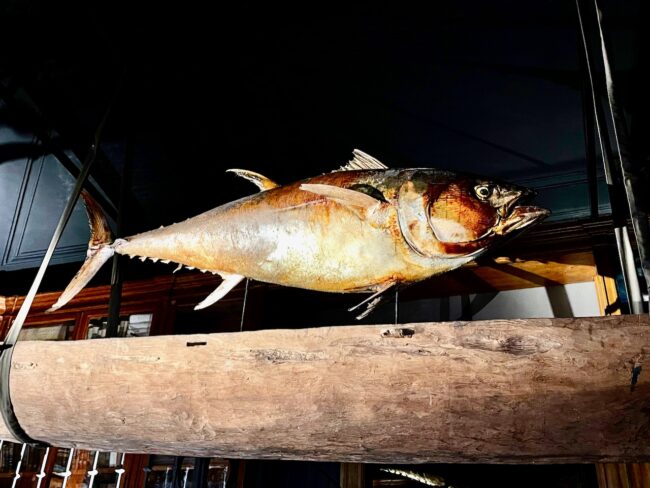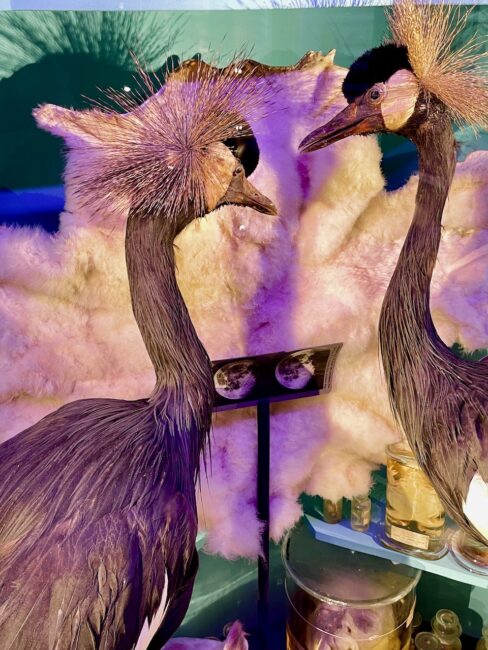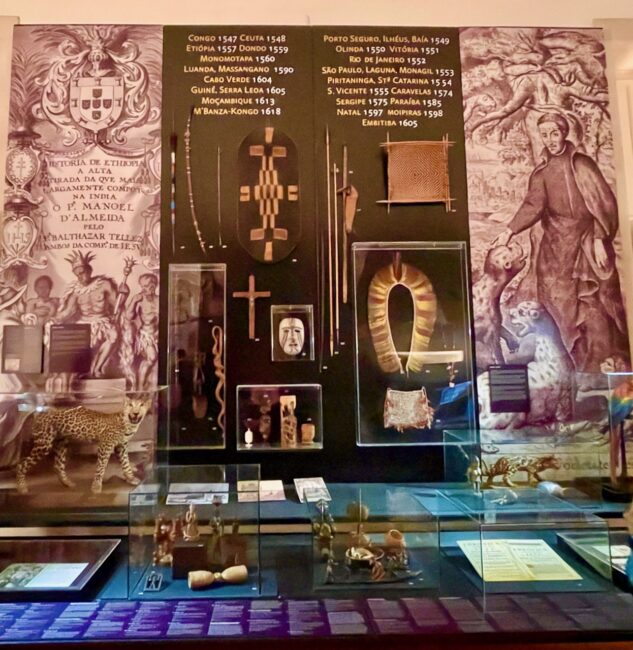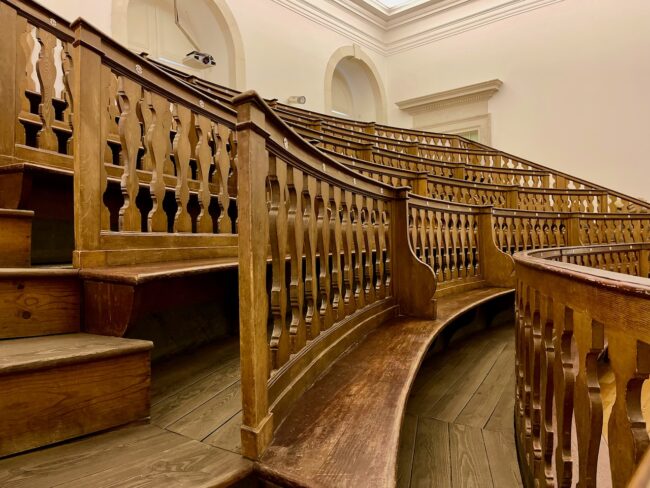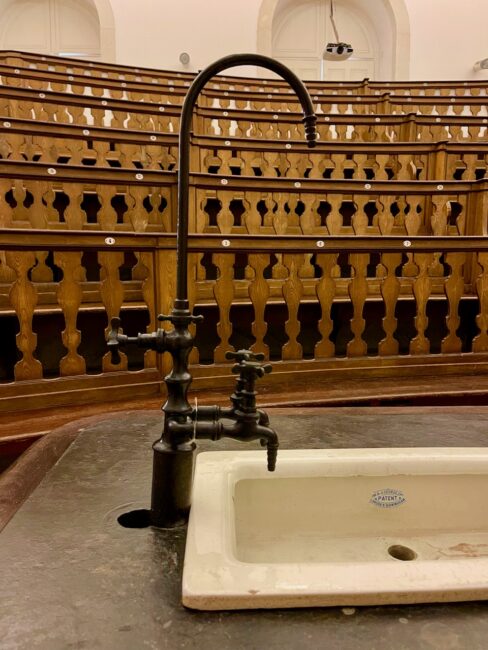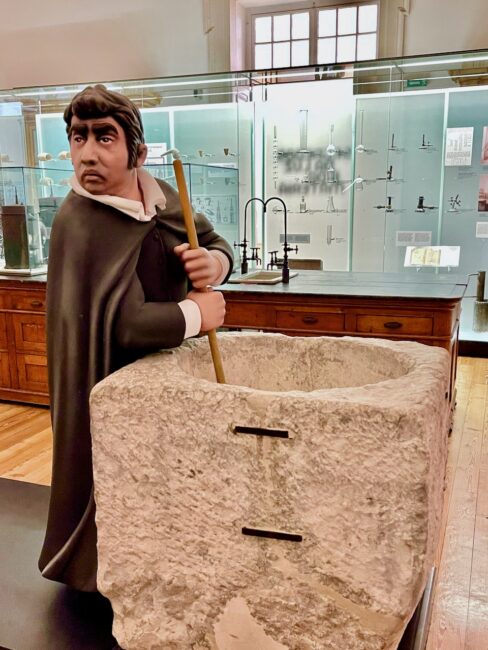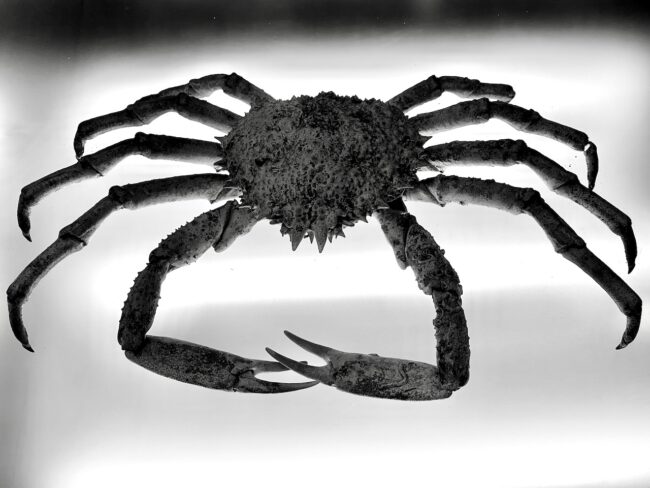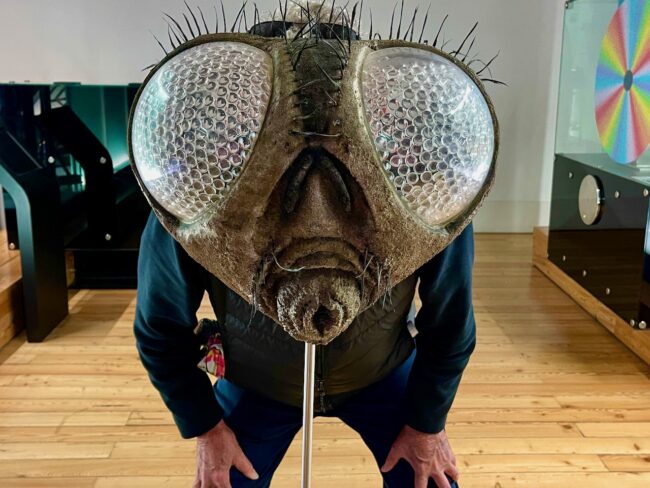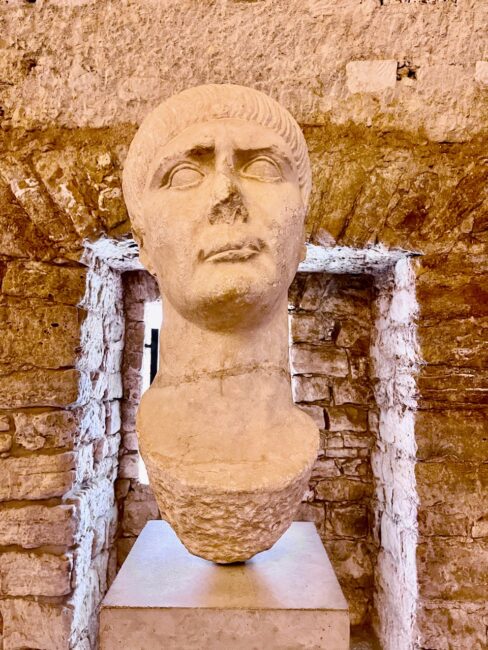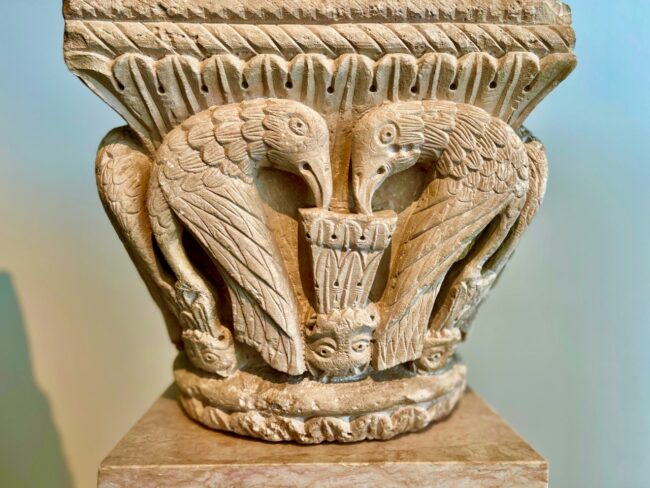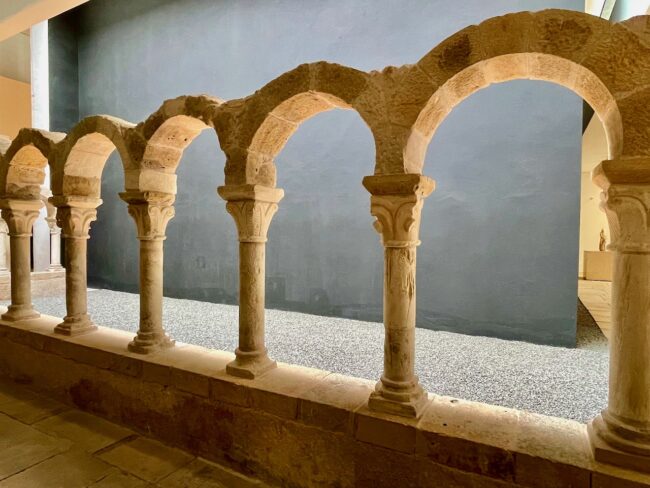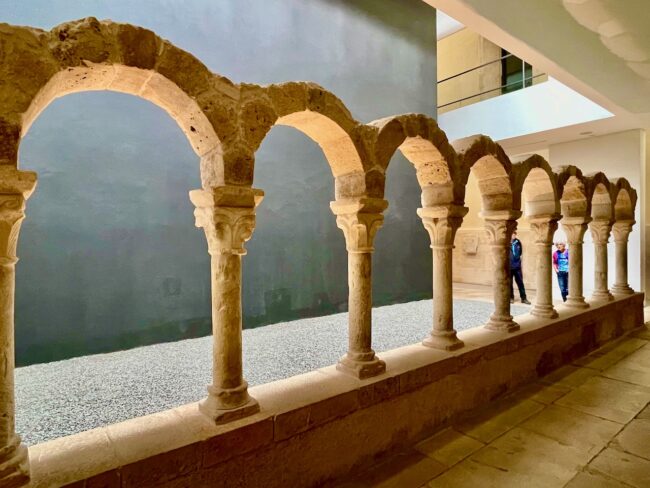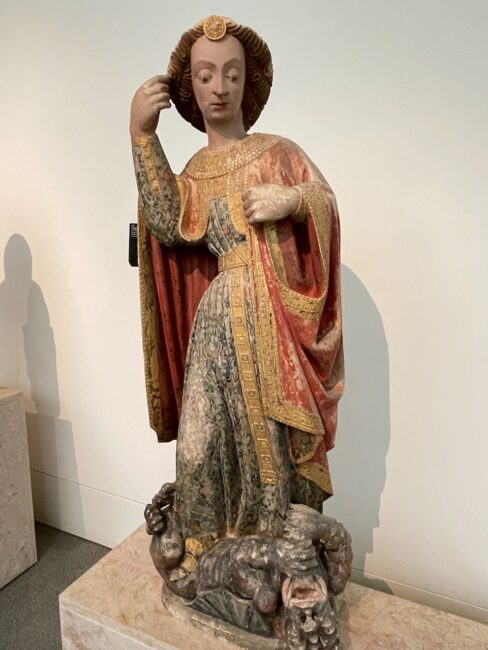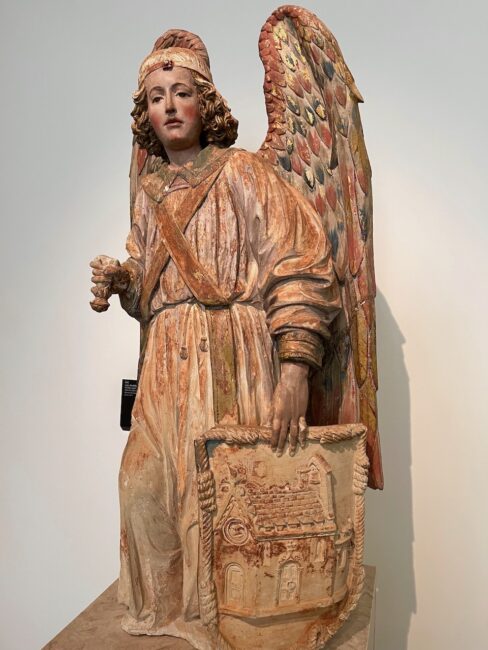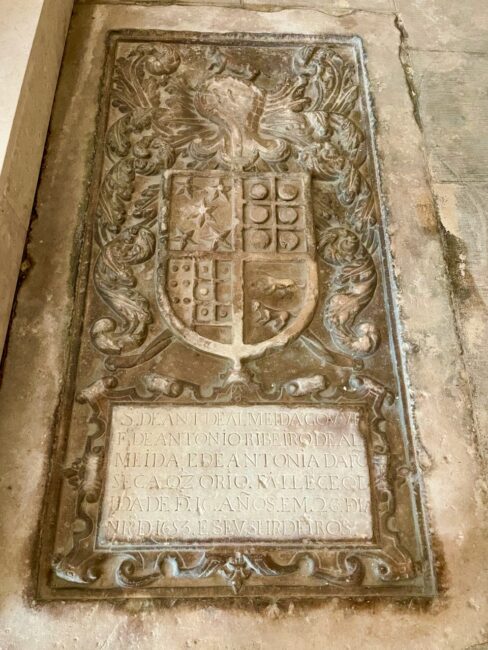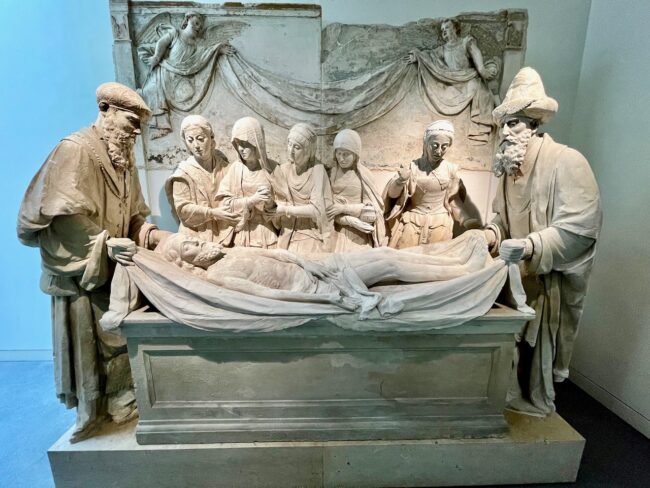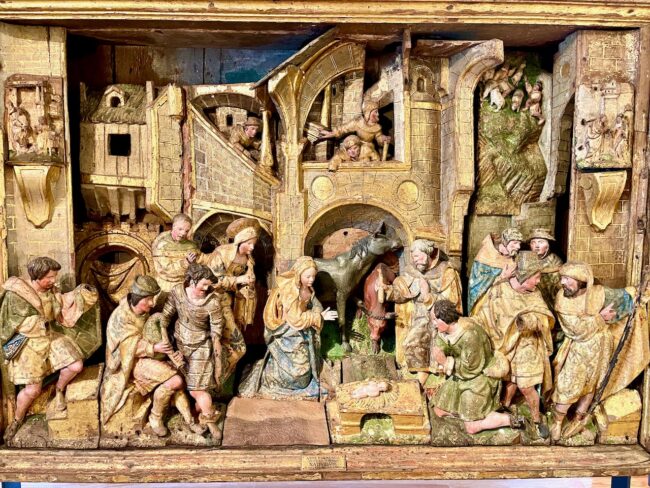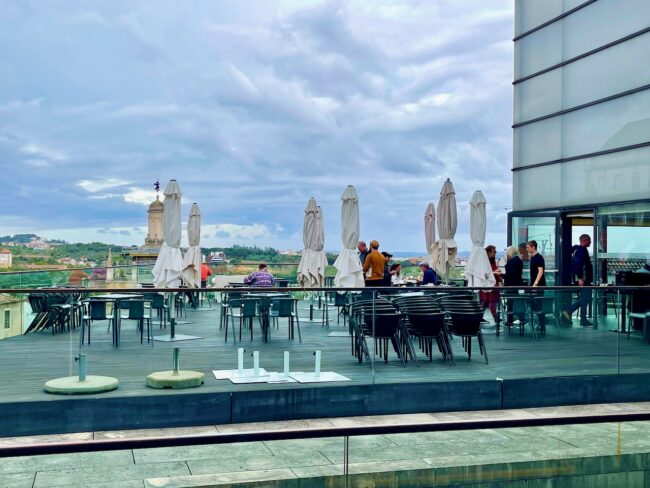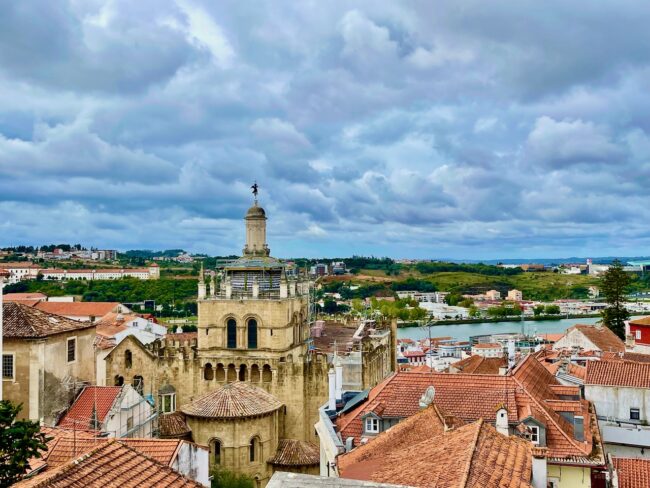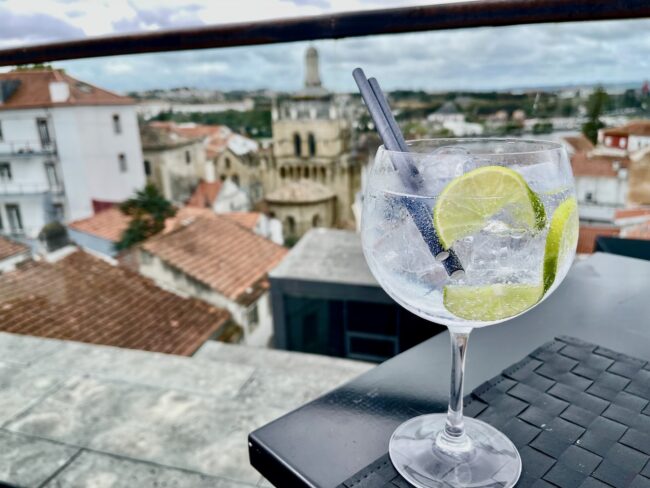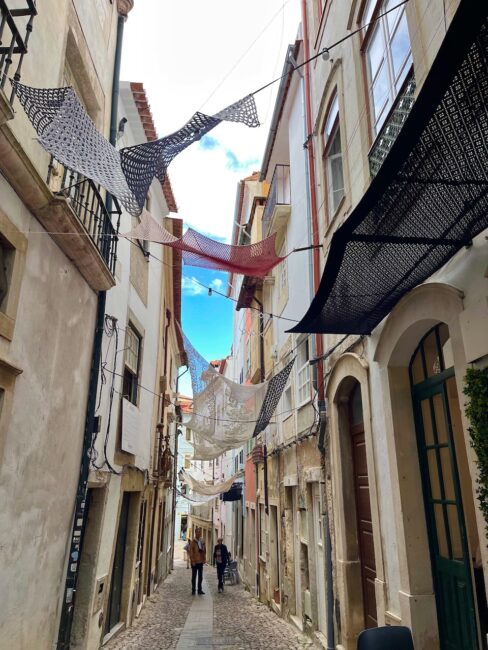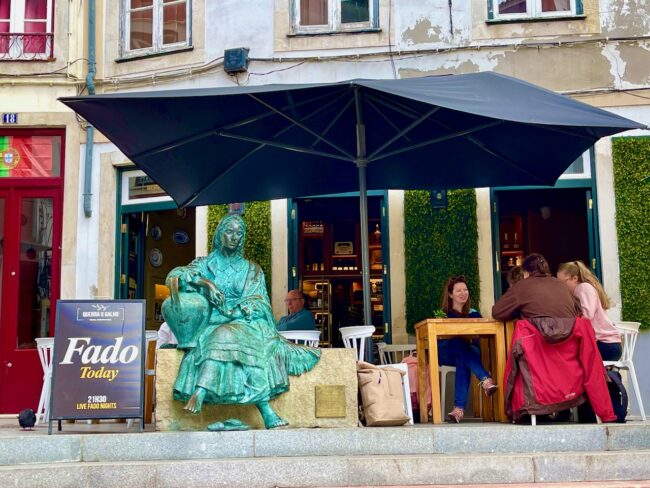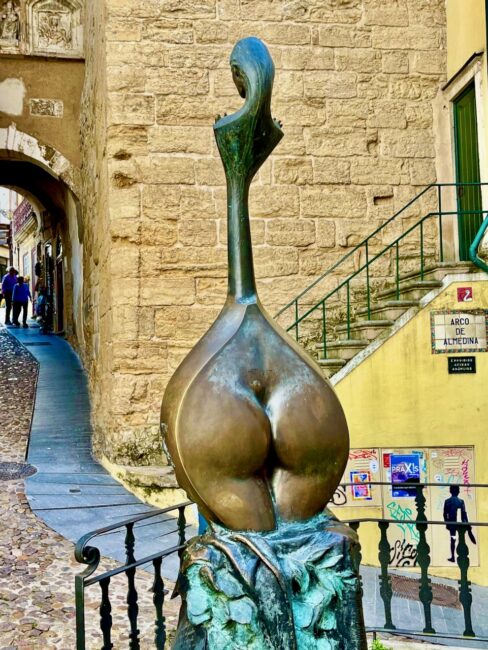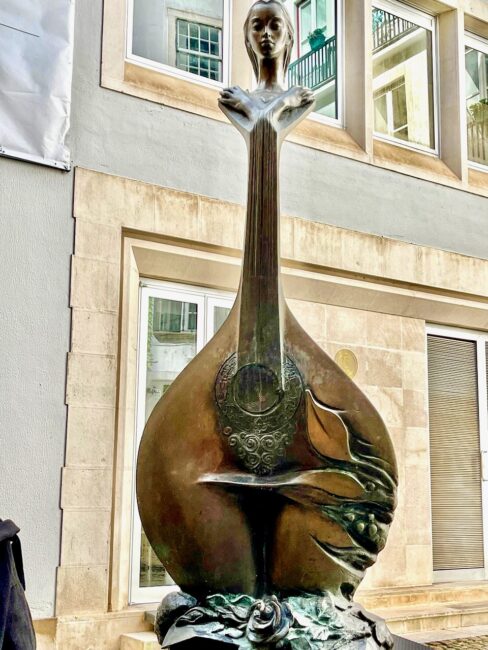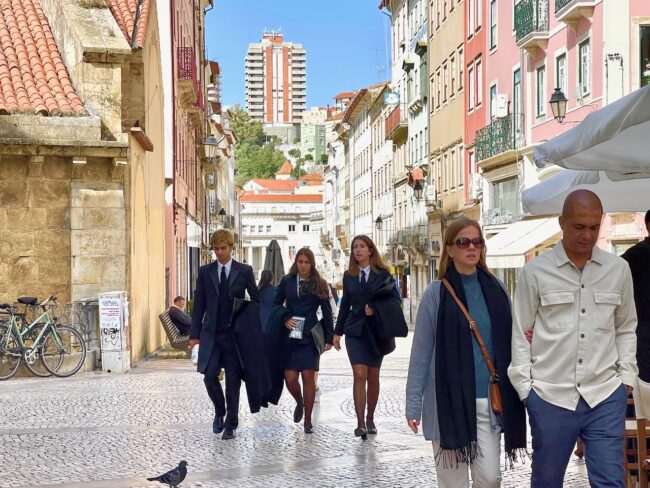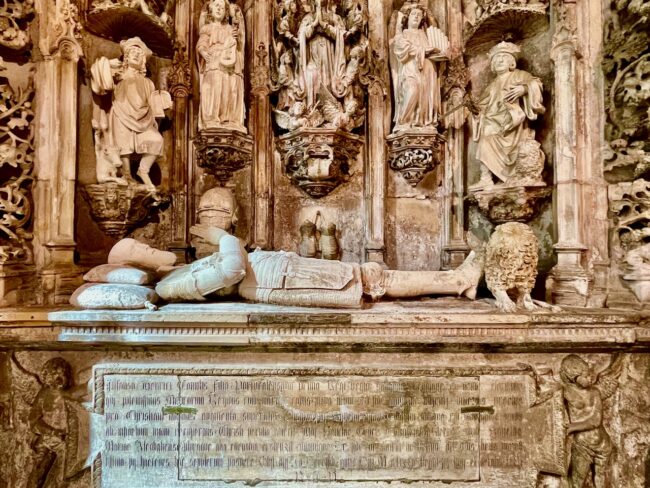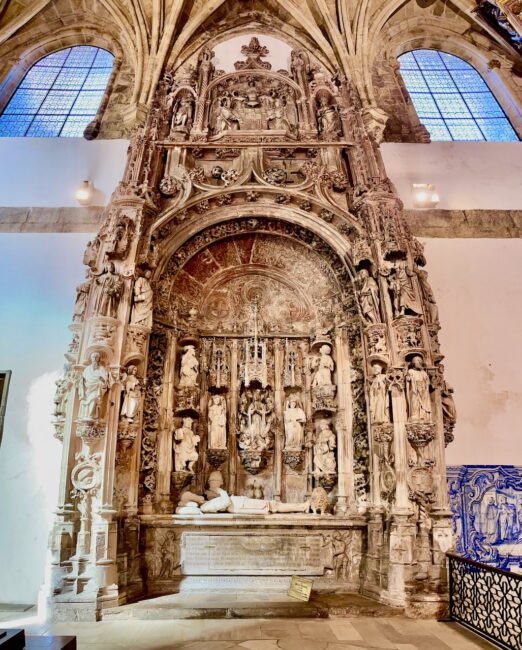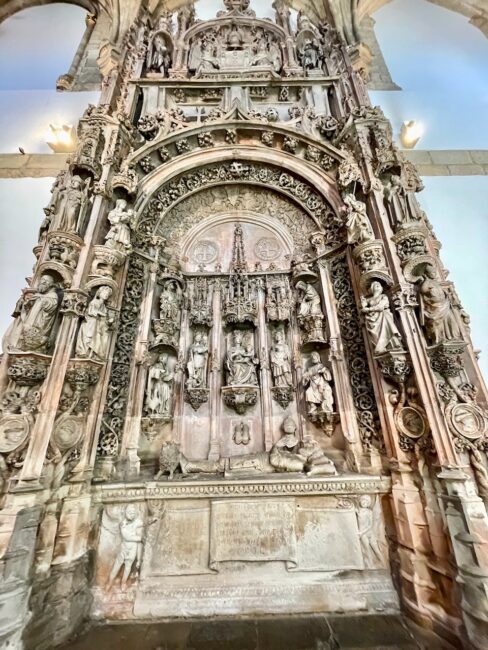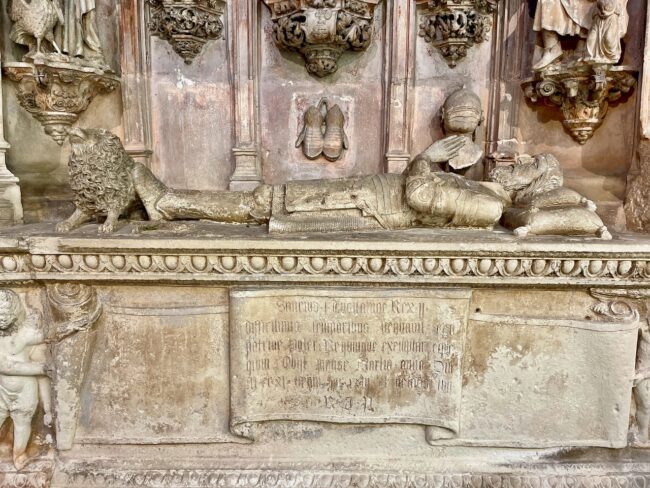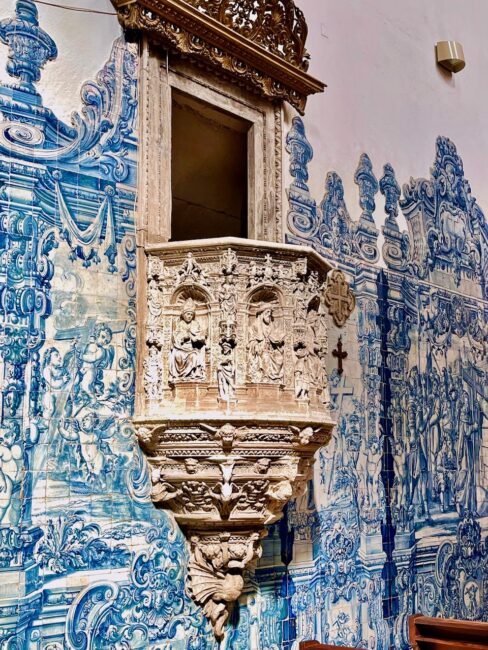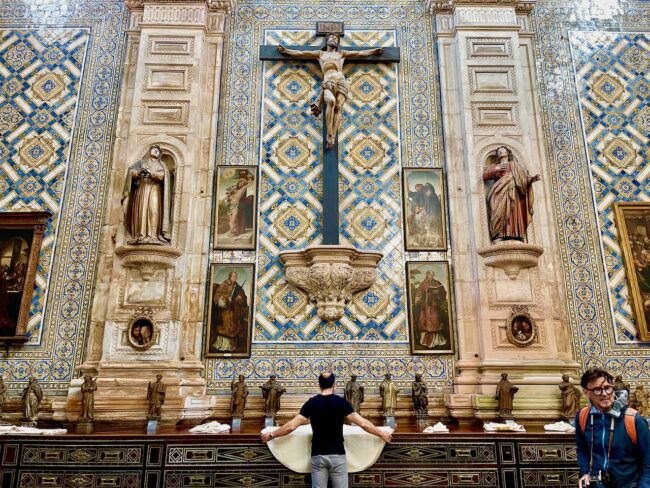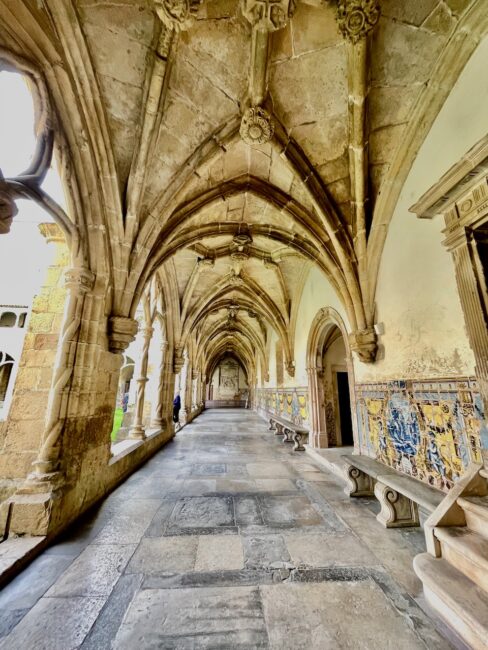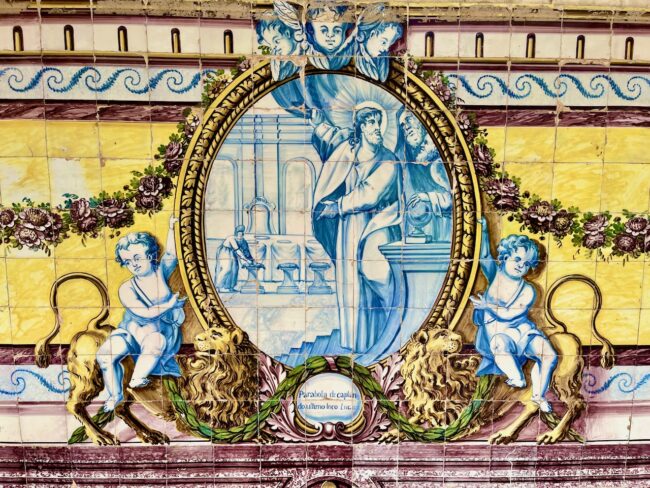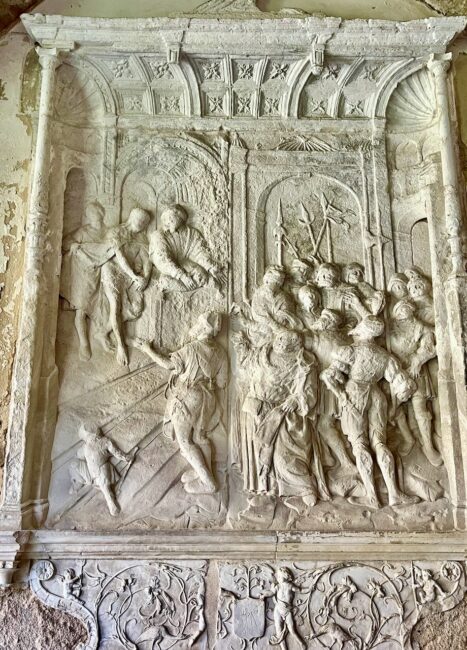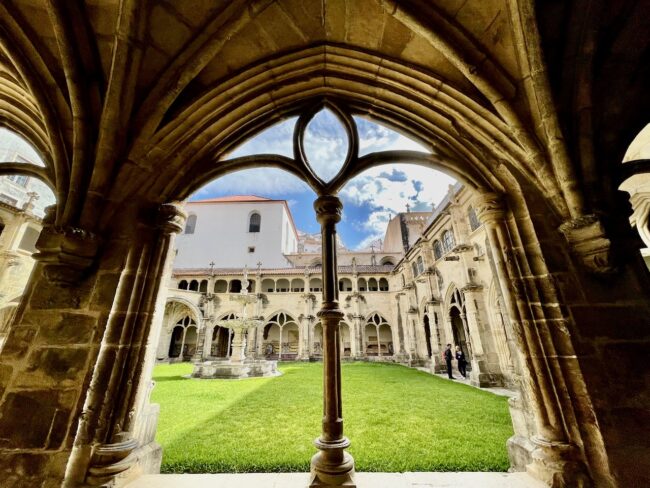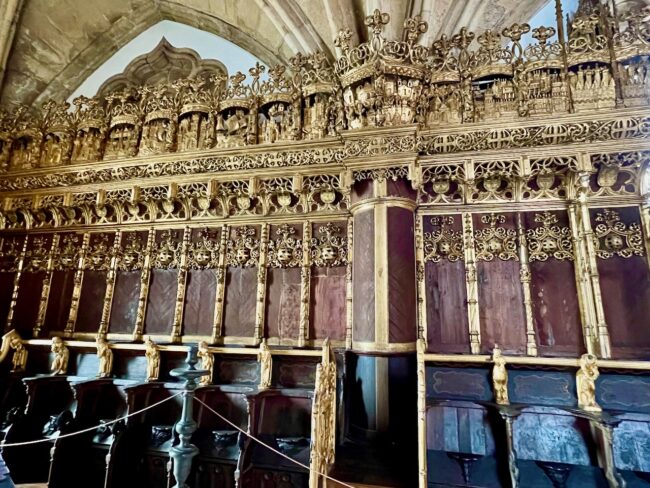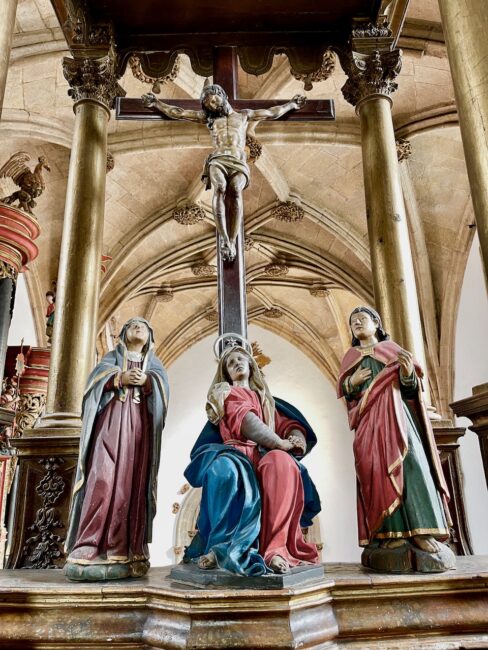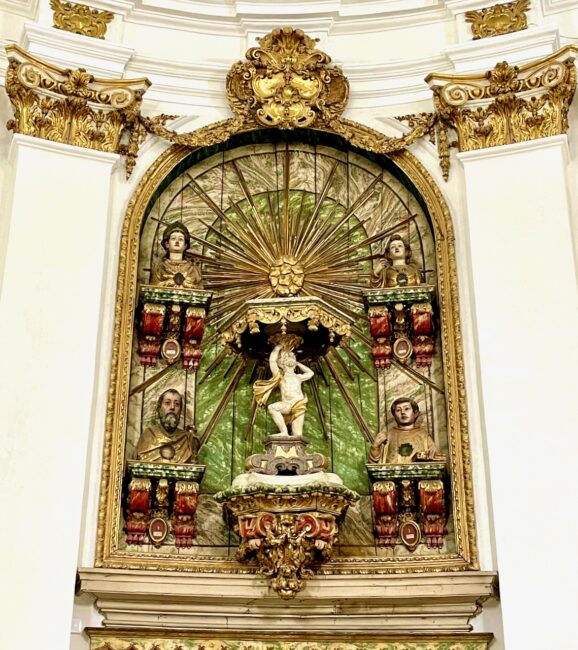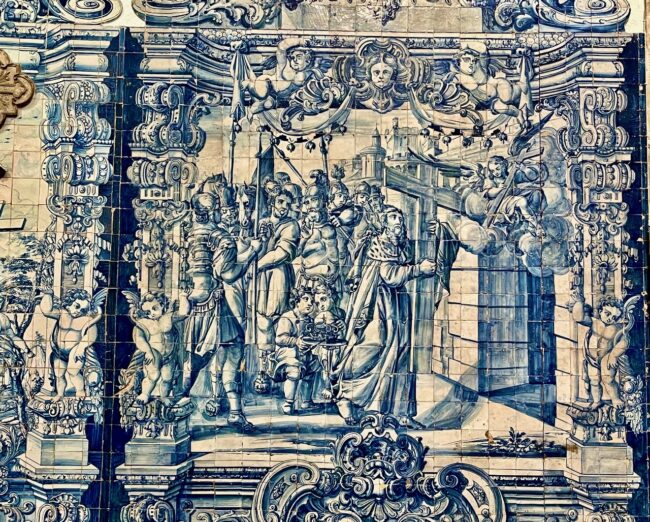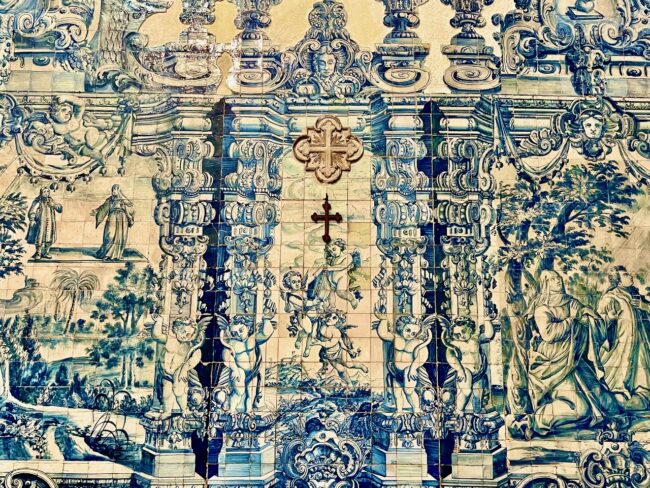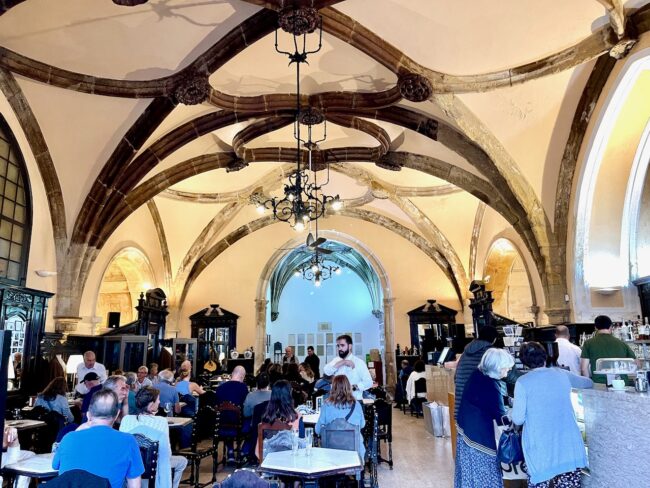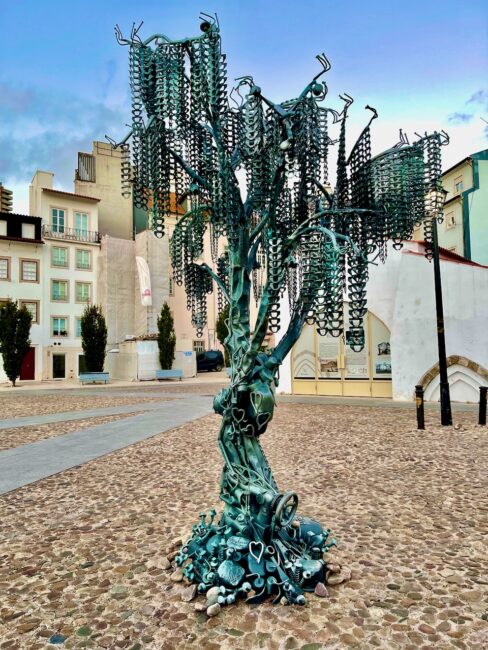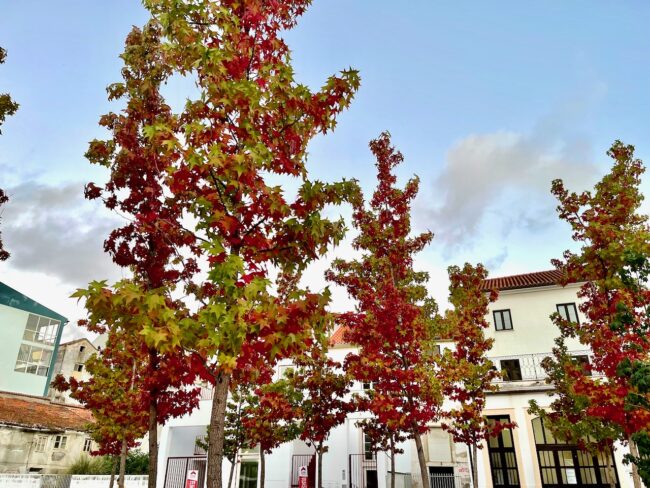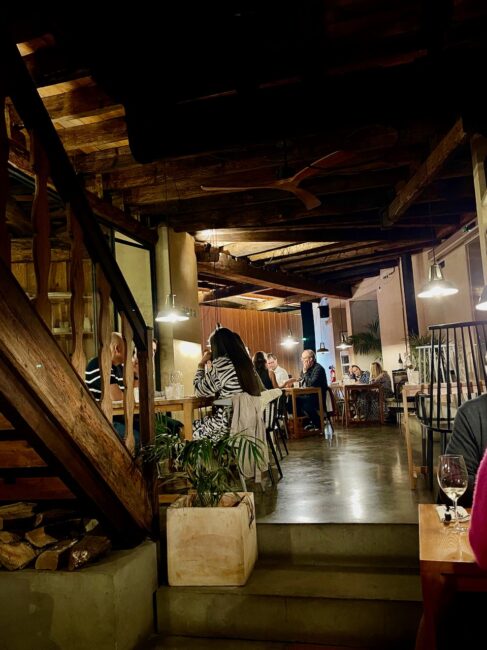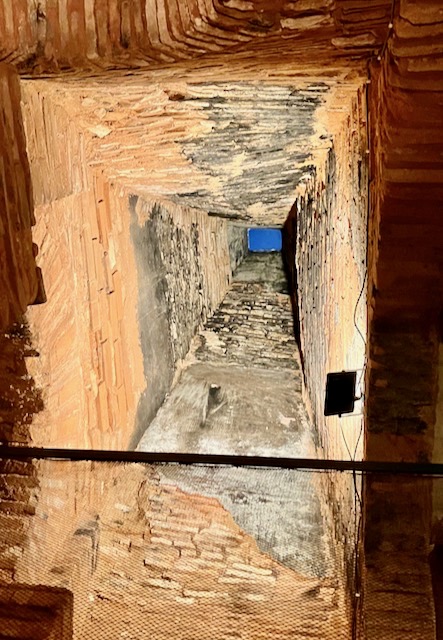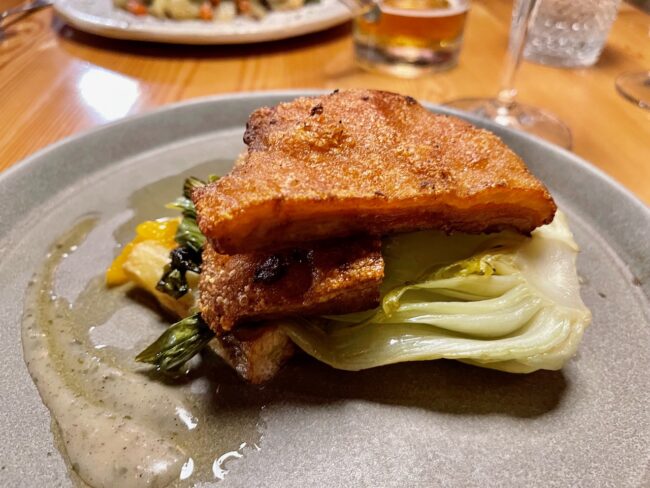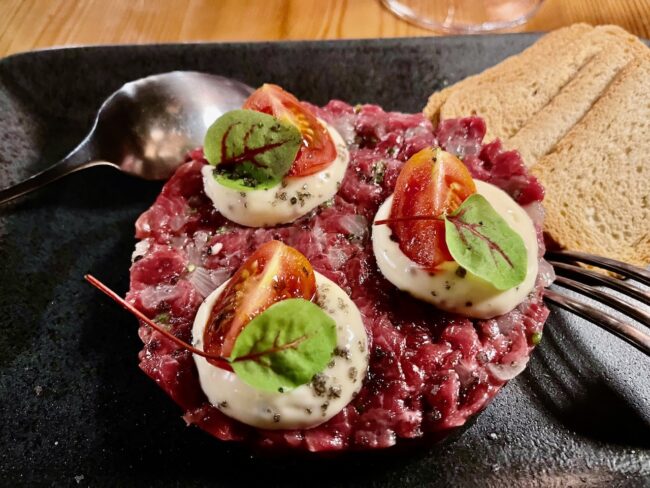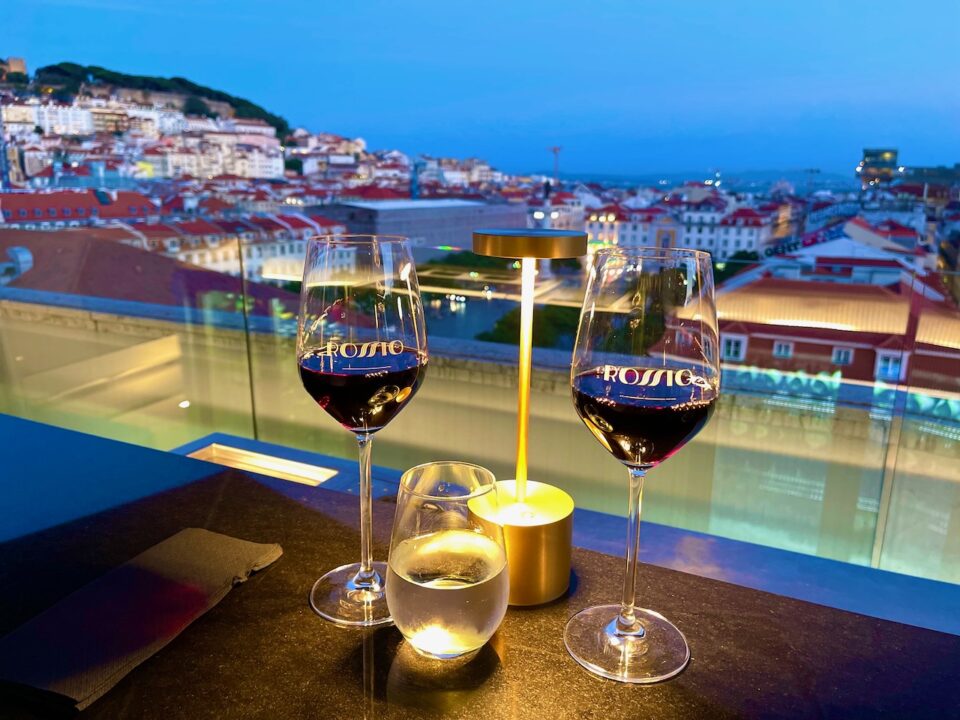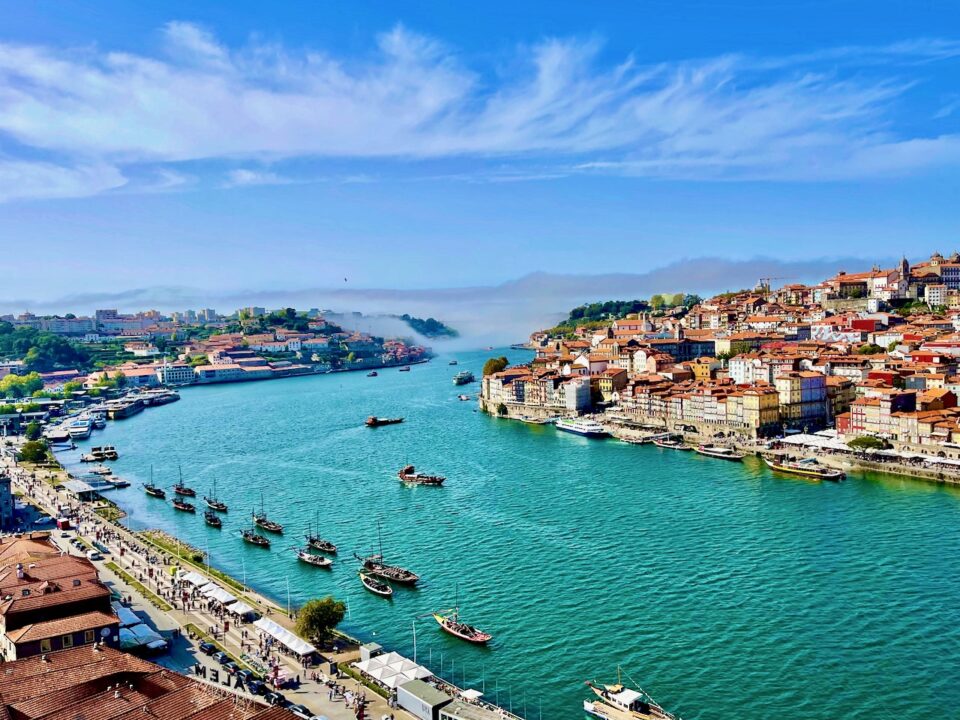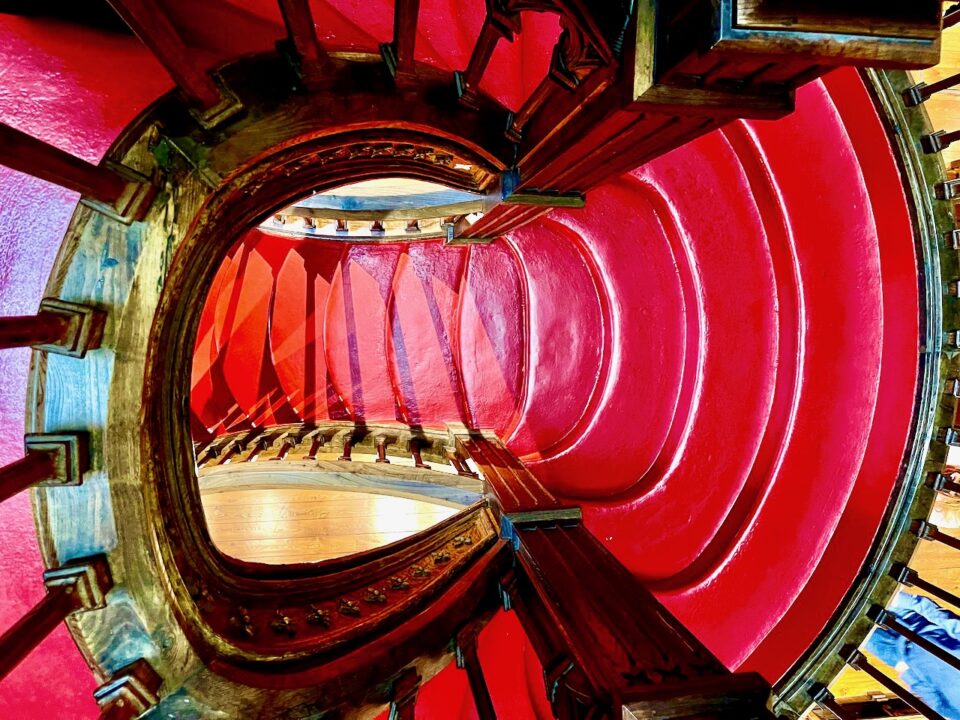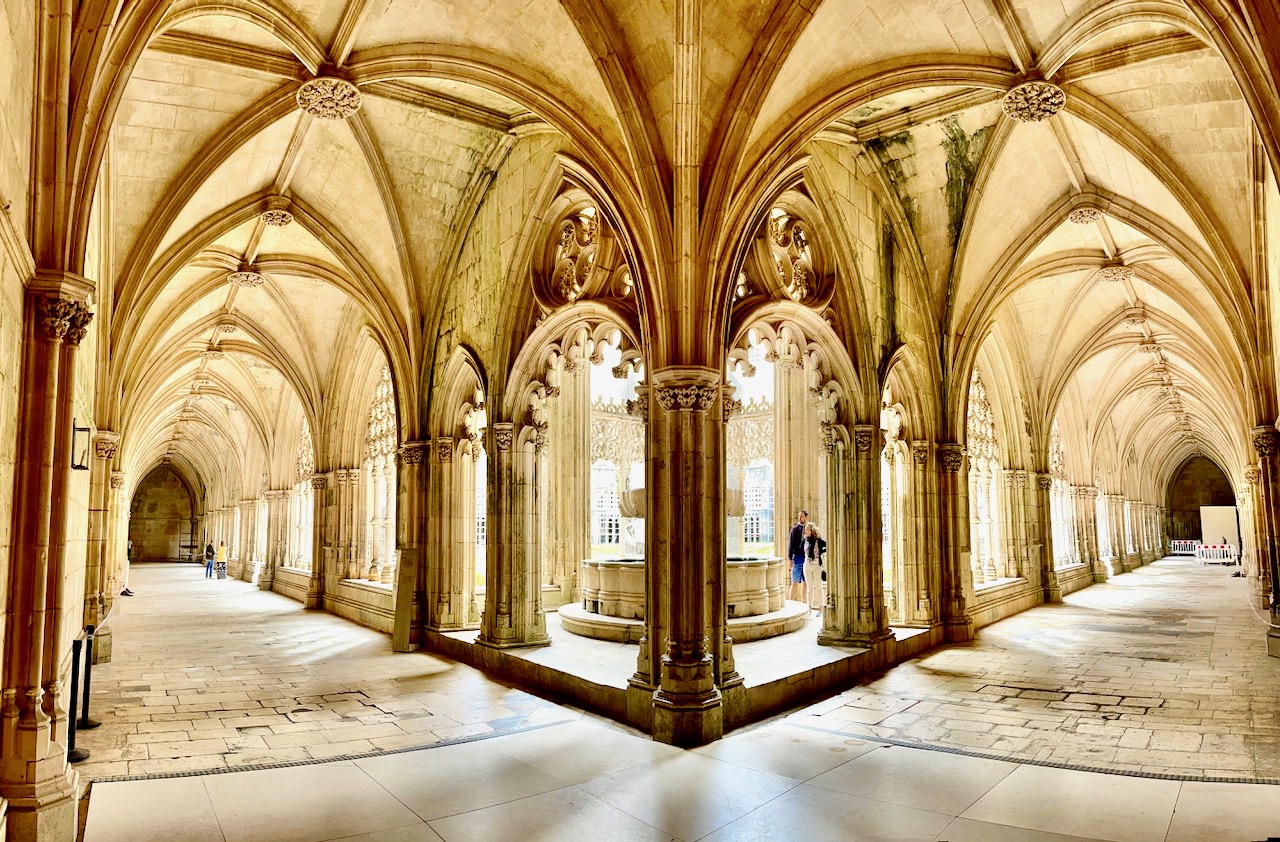
Chapter Twelve: Tomar To Coimbra
February 4, 2023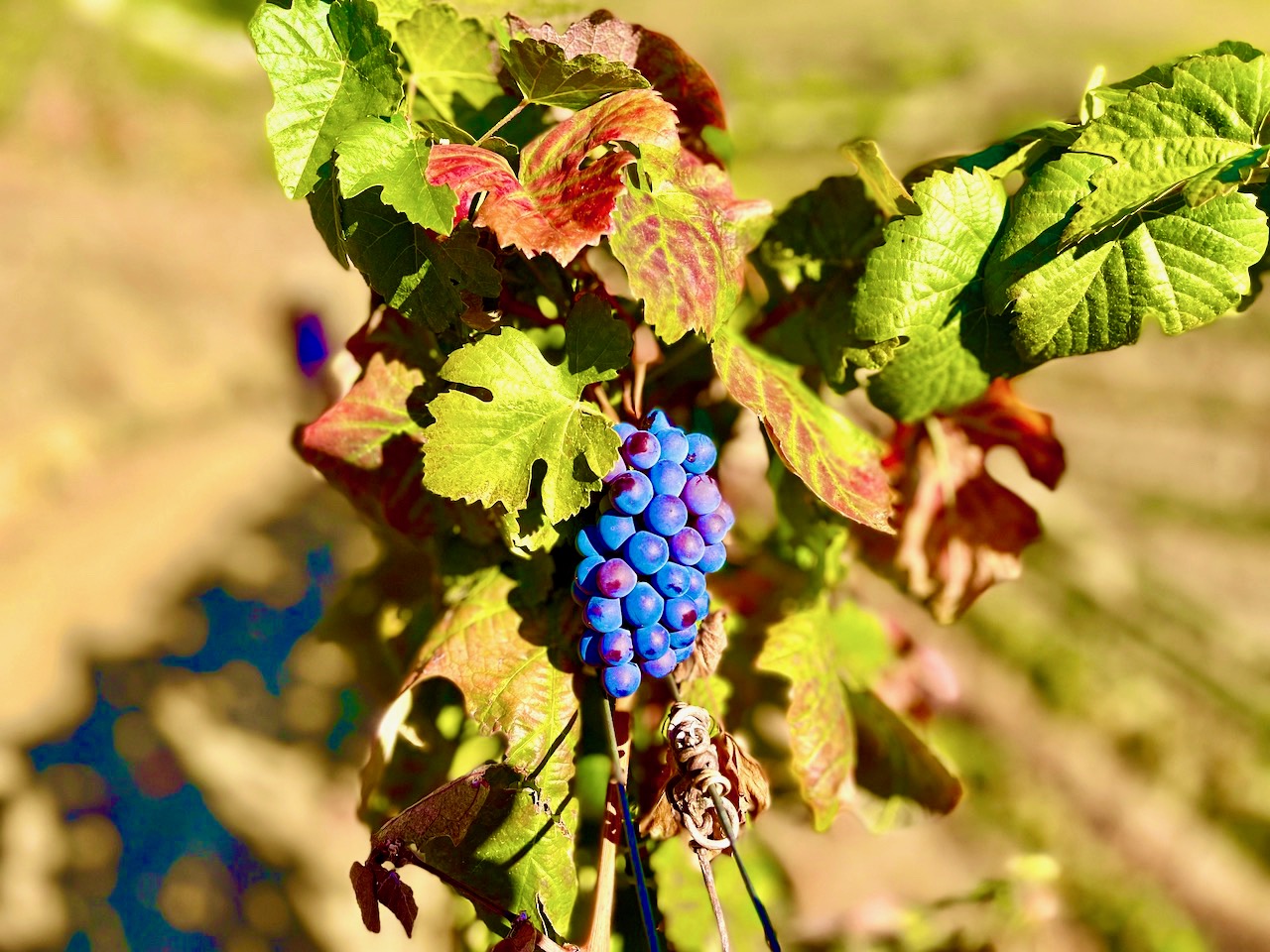
Chapter Fourteen: Viseu, Lamego & On To The Douro
February 19, 2023Falling For Portugal: A Mai Tai Tom “Trip” Report
Chapter Thirteen: Combing Coimbra
Day Thirteen: Agile Breakfast Servers, That First Step Is A Doozy, Big John, What Tour?, Bookin’ It, More Bats, Checking In With Michael, A Curious Room, Lab Rats, Trash Talking, Not Manny Machado, Lunch At The Museum, The Giant Gin & Tonic, Tower of Power, Butt Statue?, Surprise Monastery, That’s Our Parking Lot, “Cafe of the Intellectuals,” Dinner At Pottery Barn and Open The Flue
We heard footsteps on the staircase at 8 a.m., which could only mean one thing: breakfast was served. Inside the basket that our hotel personnel braved life and limb scrambling up the steep stairs to deliver were hot scrambled eggs, rolls, cheese, cold cuts, baked pears, cereal and yogurt. With so much food, I asked Tracy if we were having guests over.
Meanwhile, Mary thought she could help out by going down to retrieve her basket. Unfortunately, her motto of “that first step is a doozy” came back to haunt her. She took a misstep and nearly tumbled down the flight of stairs, only to be saved by grabbing the rail at the last moment (re-enactment).
Tragedy averted and stomachs full, it was time to go to college. I had reserved a 10 a.m. tour of the Universidade de Coimbra, which also includes a visit to its big ticket item of the 18th century Biblioteca Joanina. On a rainy Thursday morning we entered a courtyard called Pátio das Escolas dominated by the gigantic statue of King João III. The university which was established in Lisbon in 1290, moved back and forth between Lisbon and Coimbra several times and finally João III re-established it here in 1537. The campus is now a UNESCO World Heritage site. I could almost hear Jimmy Dean belting out, “Big King John!”
We found the spot where the tour was supposed to meet and everything seemed fine, except for the fact there was no tour guide although a crowd was gathering. Finally someone opened the door and waved us into a room with books (that was not the Biblioteca Joanina).
Perplexed, we walked in (after showing our letter from the university stating the four of us were allowed to be here), and a few minutes later we were led upstairs to the Biblioteca Joanina, where we were allotted ten minutes to view the dazzling display of 40,000 or so ancient books and manuscripts the library contains. There were strict orders of “No photos” and we could see a couple of people giving everyone the eagle eye (the two photos of the library are from the internet).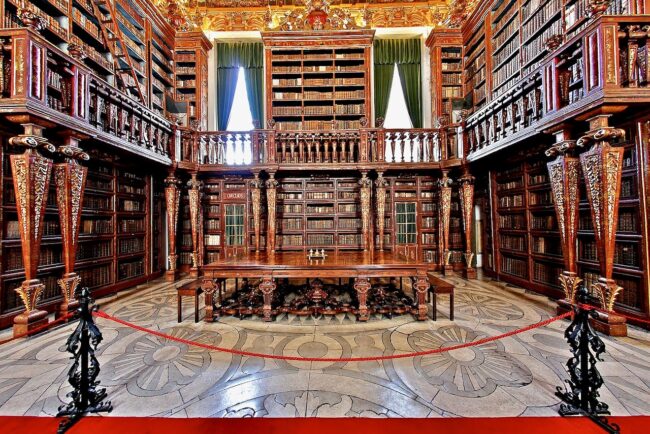
The library was constructed on the orders of King João V in 1720 (finished in 1728) on top of the ruins of a medieval royal prison. The painting in the photo below is of the king on what is called The Noble Floor. I had read that the library would be the last stop on our “tour,” so I figured we were on our own, which was actually fine with us as long as our papers of transit could get us in to all the places the tour was supposed to go (it did). We were told that this library (along with the one at Mafra Palace) are the only two libraries in the world that have bat colonies to keep pesky pests from eating the pages. Whether that’s true or not, I’m not sure, but it was kinda neat to hear about these bats in the biblioteca. They’ve been hanging out here for more than two centuries keeping these books safe.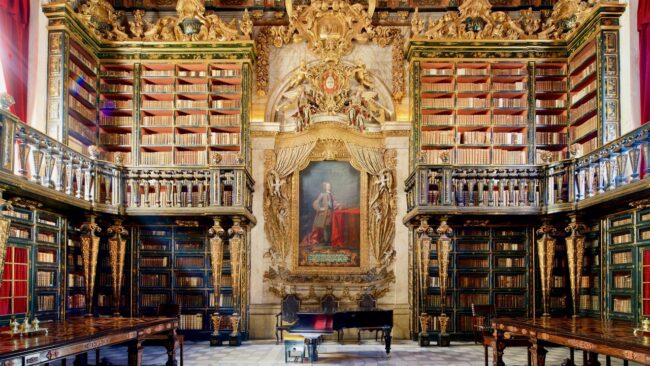
After our ten minutes in the library we were back outside the Manueline Portal of Capela de São Miguel (St. Michael’s Chapel).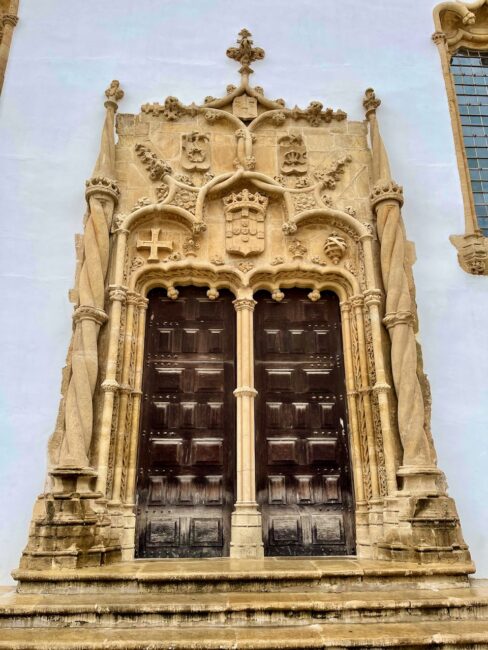
In we went, and where happy to learn we could take photos here. 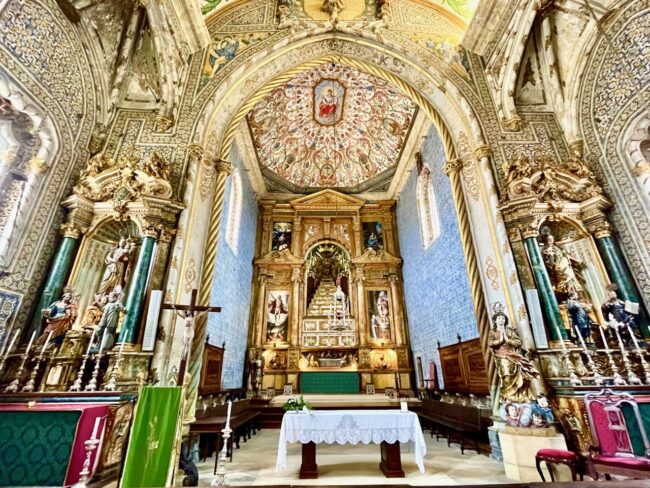
The chapel dates back to the 16th century.
It was pretty small, but the 18th-century organ (still operational) that has 2,000 pipes is not. The trumpeting angels on top are a nice touch.
The ceiling (you knew we couldn’t forget that) is from the 17th century.
It was renovated and furnished with a more up-to-date coat of arms.
That was it for the chapel, so now we were really on our own. We had no clue where our tour guide vanished to, but it really didn’t make difference.
I read on my ticket that we were allowed entry to the Royal Palace, which happens to be Portugal’s oldest palace, built near the end of the 10th century. In the 12th century it was the home of Alfonso Henriques, who was the first king of Portugal. As a matter of fact, all the Kings of the Portuguese first Dynasty lived here, a period spanning 240 years. The palace was not hard to find.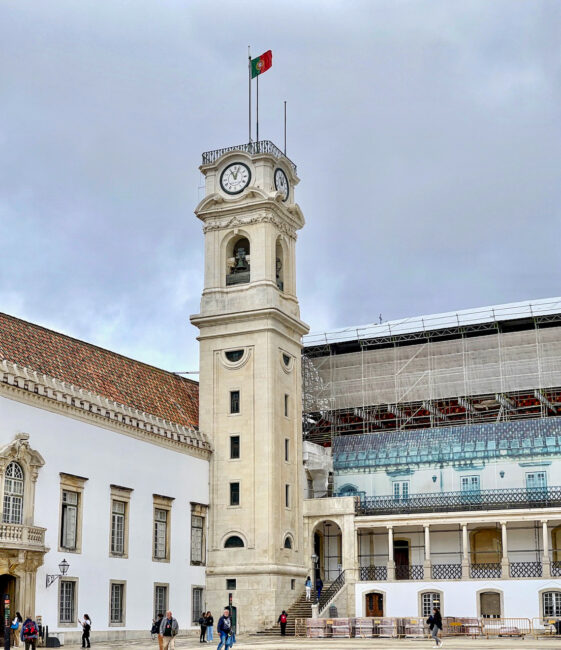
Entering the Hall of Arms, I expected to see a bunch of limbs, but it actually is the armory.
We ducked into an area adjacent to the Hall of Arms. I could only ascertain that this called The Yellow Room. Portraits on the yellow silk wall are of 19th-century rectors.
Next up was the The Great Hall of Acts, which at one one time was the Throne Room of the Royal Palace in the Citadel. There are large canvases with the kings of Portugal on the walls. Various ceremonies are held here, including doctoral theses.
The intricately designed ceiling panes were created in the 17th century.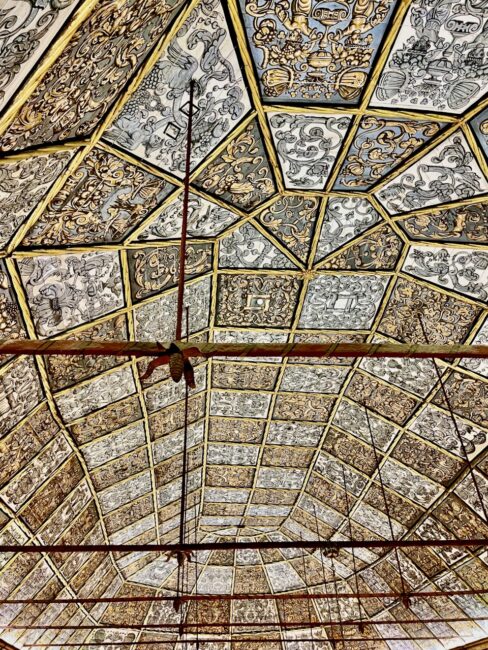
Tracy said, “Let’s go to the Private Examination Room.” “I’m not even sick,” I replied, not knowing that this was once the king’s quarters, but is now where graduates of the university take their examinations. The colorful ceiling is from 1701. Kim caught Tracy in the act.
She was able to zoom in on the Coat of Arms of the Kingdom of Portugal …
… and “representations of the former great Faculties at the University of Coimbra.” This one, featuring a swan and the staff of Hermes, represents medicine.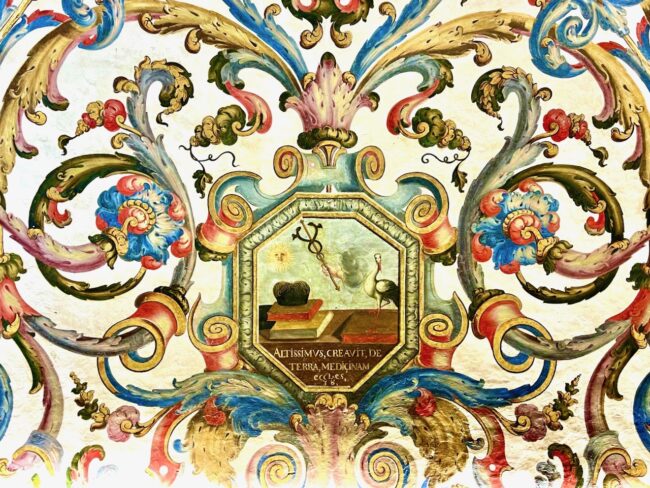
Back outside we checked out King João III’s humongous statue up close. Something I learned while there was that Coimbra is known as the “Athens of Portugal,” due to its culture and heritage, and the fact that it is the birthplace of six Portuguese monarchs. I should have studied this much at San Diego State.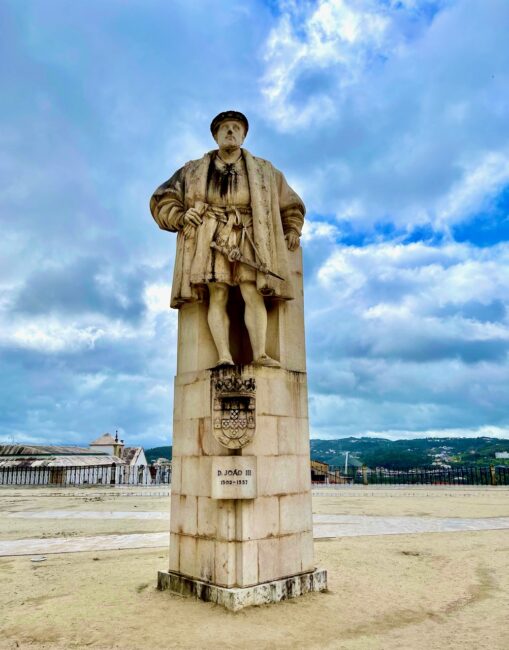
Our next goal was to find something called the Cabinet of Curiosities. Curious as to where it was located, we asked a few people for directions but received no definitive answer (we could have used a tour guide at this moment). We wandered and wandered and instead of the Cabinet, we stumbled upon the nearby Sé Nova (New Cathedral of Coimbra). “New” being a relative term because the church was built in the 1500s, later becoming Coimbra’s New Cathedral.
The gold altarpieces were added in the 1700s.
We stopped by the Nossa Senhora da Boa Morte (Our Lady of Good Death).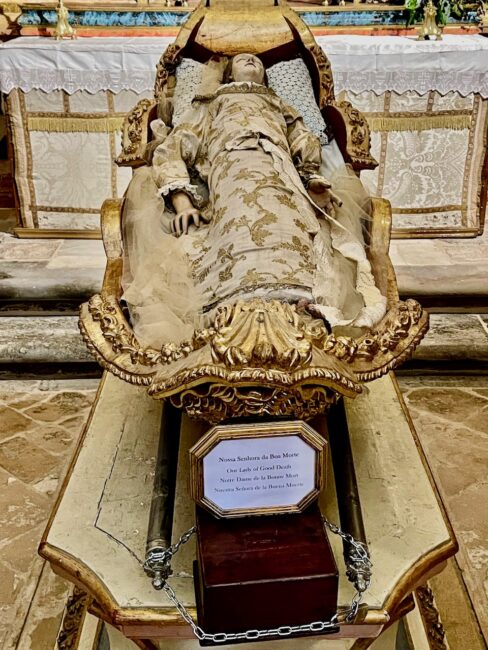
Lots of gilded woodwork can be seen throughout the church.
In The Chapel of Saint Ignatius of Loyola, for 50 cents the tomb lights up. I’m a sucker for those.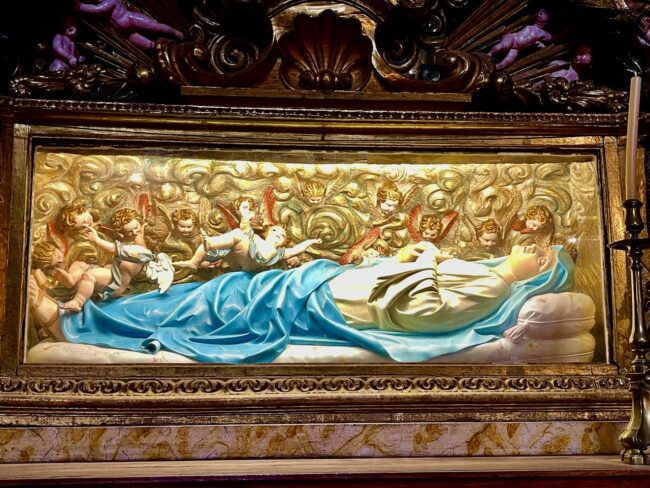
Finally, we saw a reliquary that reminded me of Thing on the Addams Family TV show. I forced myself not to say, “I’d give my right arm for that.”
Somehow (I really can’t remember how), we found the Cabinet of Curiosities. It turned out to be very interesting. I mean how many rooms have you been in with a cow skeleton and a crocodile hanging from the ceiling?
From the university website, Cabinets of Curiosities “were mainly created by the European nobility, who tried to gather in these rooms a set of objects, such as exotic pieces, in an attempt to recreate the work of God. The aim of these cabinets was to display rare, exotic and even bizarre objects, so as to amaze the visitor and simultaneously show the cosmopolitan vision of their owner.” That certainly defines this room.
The Science Museum at Coimbra University opened the Cabinets of Curiosities earlier in 2022. It took three years, 10 people and an investment of 250,000 euros to “ recreate this nearly magical atmosphere.” They could have added macabre, as well.
A donkey with six legs, skeletons and skulls were just a part of this menagerie of unique items that have no captions or labels to say what they are.
They are not displayed in any semblance of logical order. Some could be a little fishy, while others monkeyed around.
The lighting in the room definitely adds to the mystique of the items in the cabinets. This guy did not look good.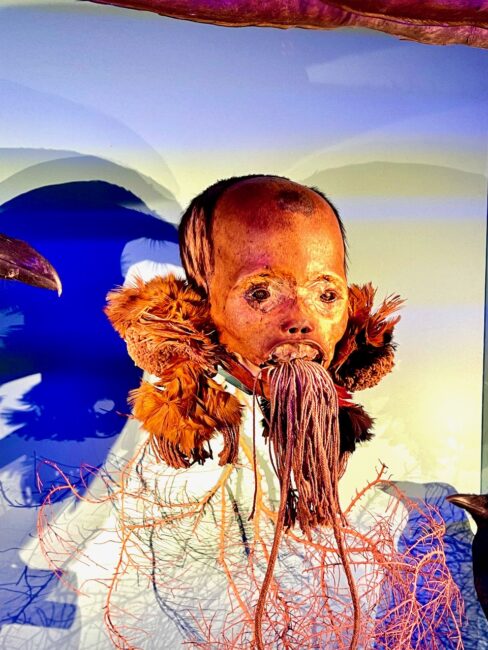
We spent a lot more time in here than we first thought we would, and it is quite a memorable experience.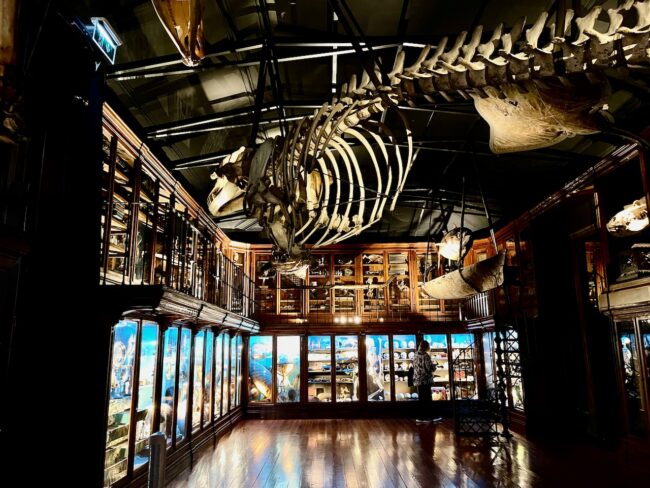
Our final stop on the university “tour,” was the Chemistry Laboratory, which has a “unique collection of the 18th and 19th century experimental devices.”
I guess this is where students sat to watch different experiments.
I could tell this guy was about to stir up some trouble.
Pigments and dyes for all sorts of experiments are located in the room.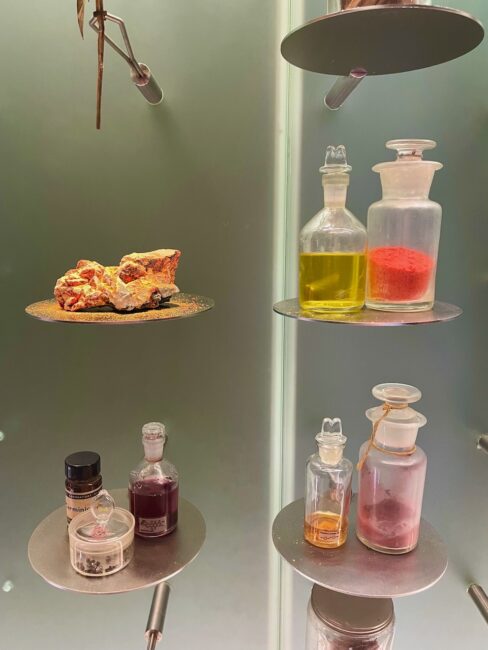
I kept an eye out for this exhibit.Socket to me!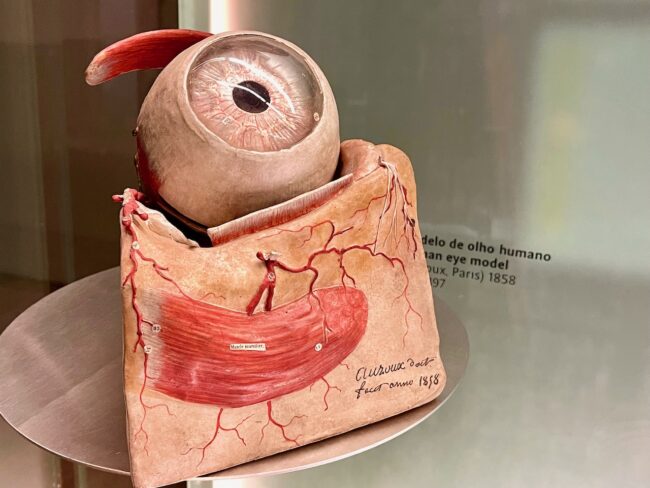
After checking out a European spider crab, I auditioned for a part in The Fly.
There was no Donna Summer tunes playing when we checked out the Disco de Newton (Newton’s disk). When this spins, the colors fade to white.
I don’t know what this feathered creature did to be called the Lesser Bird of Paradise.
Outside the Science Museum we admired a piece of street art on the side of the College of Arts that looked like a larger version of things we saw in the Cabinet of Curiosities. I later learned it is called “A Young Owl” by Bordalo II, a Portuguese activist and trash artist who utilizes street garbage to create animal sculptures to warn about pollution and endangered species.
It took 2 1/2 hours to visit all those places, and since we had such a large breakfast, we decided to head over to the Museu Nacional Machado de Castro. I learned the name had nothing to do with Manny Machado or Fidel Castro, but was named after famed Portuguese sculptor Joaquim Machado de Castro. Its location in the former Bishop’s Palace over the ruins of the Roman forum of Aeminium (Coimbra’s Roman name) made for an interesting first stop in the museum.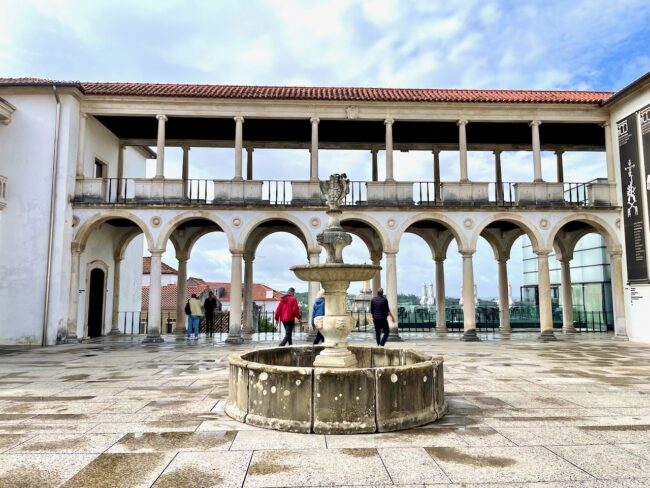
We headed down to the cryptoporticus, the Roman name for a covered corridor or passageway. The Roman Forum of Aeminium was situated on a slope so the Criptoportico de Coimbra is located on two floors.
It was pretty cool to walk through these galleries …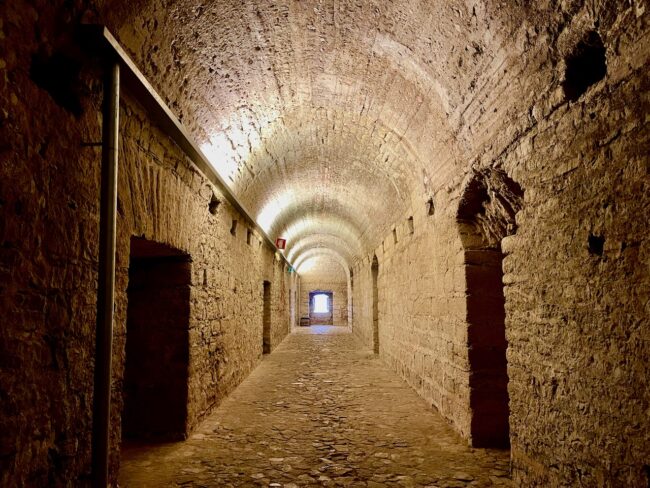
… and some of the walkways are pretty narrow, so if you’re a little claustrophobic it might not be for you.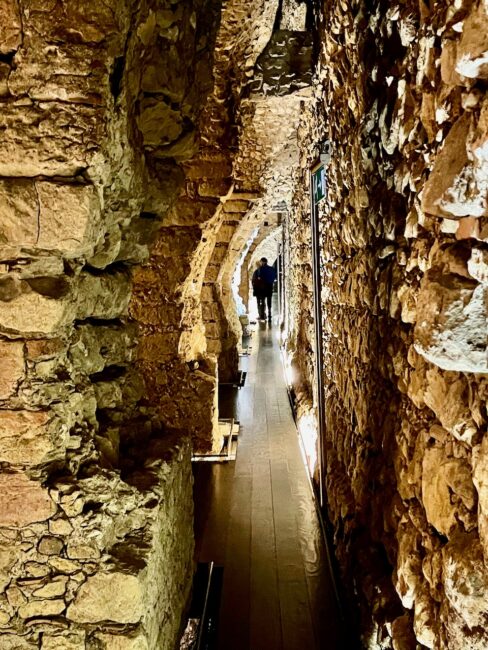
Before leaving this part of the museum, we saw the bust of Trajan.
One of the museum’s highlights is the 13th century cloister of the adjacent church of São João da Almedina.
Since de Castro was a sculptor, there were plenty of them to see like this medieval knight carved for Domingos Joanes’ tomb. He served Alfonso Henriques, the first king of Portugal.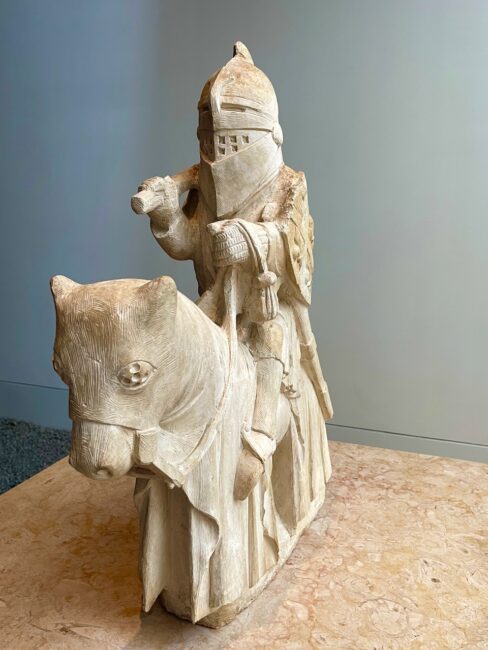
There is a lot of medieval religious art including my man Michael.
Another highlight is the Capela Do Tesouroeiro (Treasurer’s Chapel). It was once a part of the apse of the Church of Santo Domingoes, which no longer exists. I noticed all the apostles on the chapel are headless.
The Deposition of Christ (l) was created the Monastery of Santa Cruz (stay tuned) while the Altarpiece Nativity is from the Ursuline School.
We only touched the surface of the paintings at the museum. I believe this is one of an elderly Ron Howard.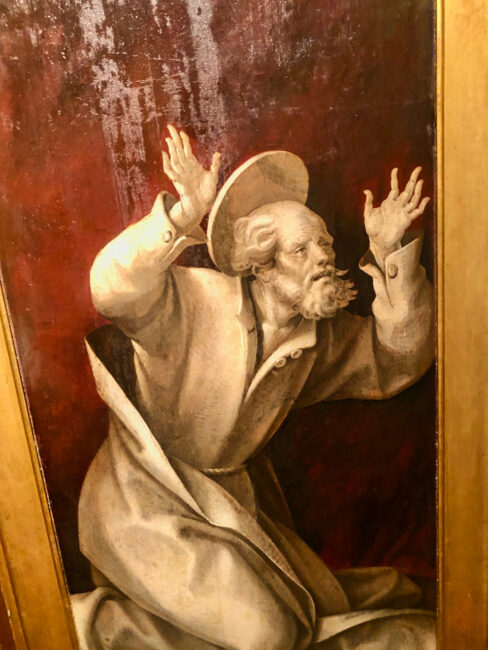
There are lots of things to see here, but finally hunger won out.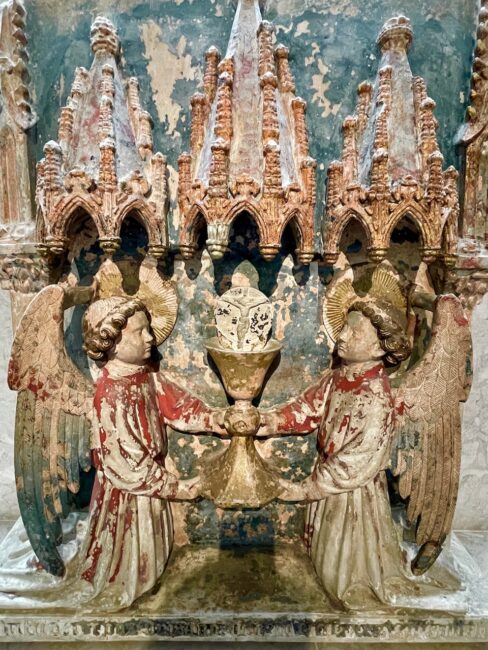
While Kim and Mary went in search of an Irish pub for lunch, Tracy and I decided to hit Loggia, the museum cafe with some nice views.
My steak sandwich with a giant Gin and Tonic was a perfect way to relax.
Tracy again went for the 5-A-Day meal.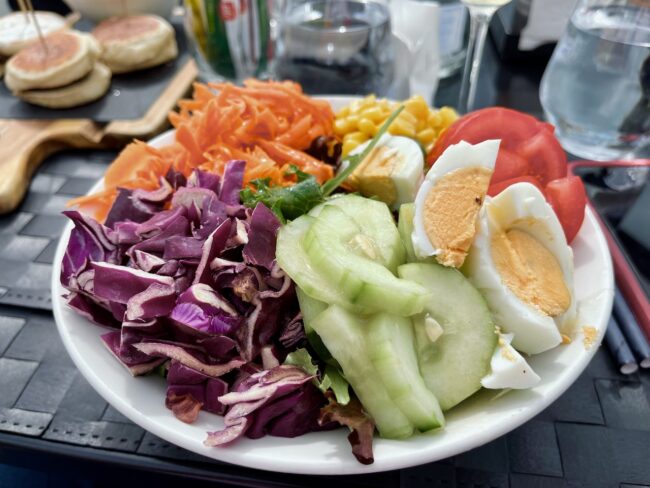
We meandered downward as the rain had seemed to be a thing of the past. Rua de Quebra-Costas that is literally translated as “Backbreaker Street” runs from the Arco de Almedina to the square Sé Velha. I read, “It should be said that this curious name was the humorous way that the people of Coimbra found to describe this steep, tortuous hill with slippery cobbles that have already caused so many falls.” We tread even more carefully. I think this statue was called Tricana of Coimbra, which supposedly “commemorates the ladies of the city who listen to fado serenades.” It’s on the Rua de Quebra-Costas.
Nearby was the Arco de Almedina, which was once a section of a medieval wall rebuilt in the 11th century by the Arab conqueror Almansor.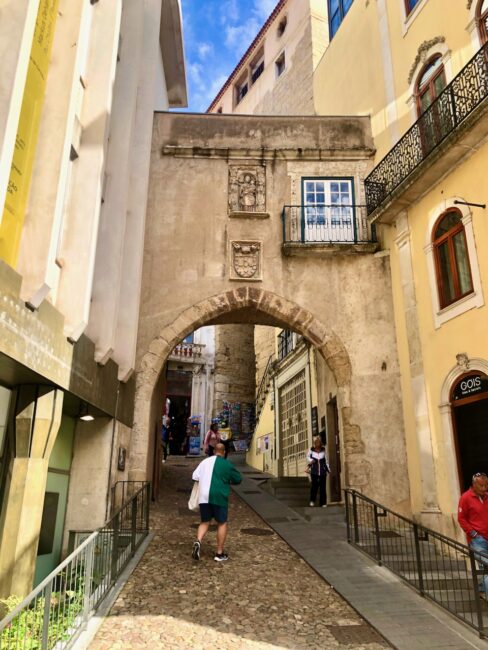
Then I saw something that definitely caught my eye. “Is this a statue of a woman’s backside?” I asked Tracy. Tracy, who was on the other side of the statue, said it looked like a guitar. As it turned out, we were both correct. The “Monument to the Fado of Coimbra” is half guitar and half woman. I suppose she would be high strung.
We were now back in the area we had been the previous evening and saw students strolling through town. They dress a lot better than I did when I went to college.
Back at the Igreja Santa Cruz, Tracy said, “Let’s go in and see if we missed anything.” As it turned out, we had missed almost everything.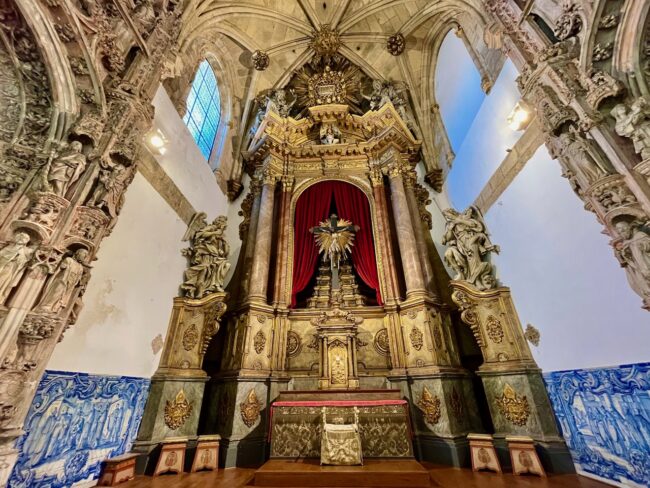
As we would learn, this church is the Mosteiro da Santa Cruz and the National Pantheon, holding the remains of kings, including Portugal’s first two kings. In this church you can walk all the way up to the altar, and of course Tracy was infatuated with its intricate ceiling.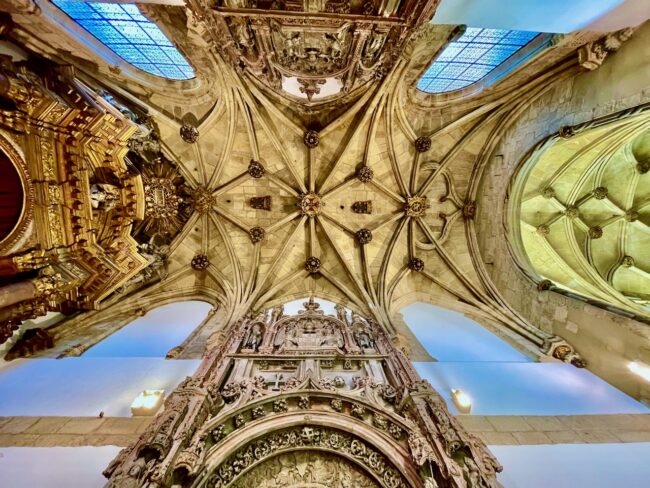
She zoomed in to get a couple of sharp photos.
We were about to leave when we saw two tombs facing each other at the head of the church. We first looked at the tomb of Dom Alfonso Henriques, the first king of Portugal. It is surrounded by musical angels, prophets the national coat of arms among others. The 12 apostles surround him.
Facing him from the other side of the altar is the tomb of his son and second king of Portugal, Dom Sancho I.
We looked up at the organ and learned something about this 4,000 pipe organ. It is so complicated that it takes four people to play. I guess if one of those people leave, they quickly get an organ transplant to help out. Another website states that only four people actually know how to play this organ.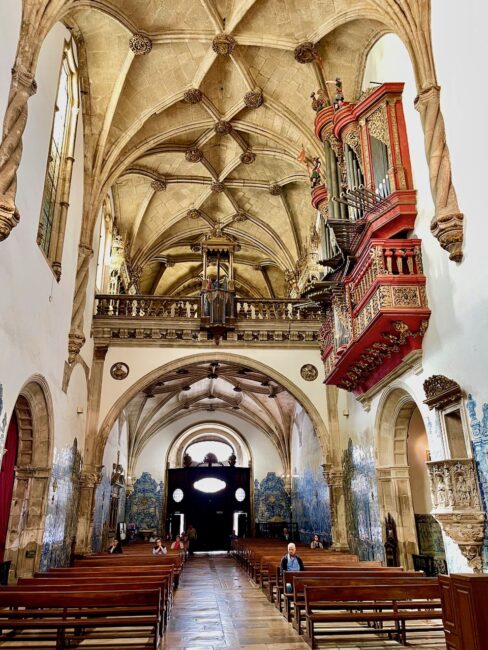
The azulejos are colorful and depict important events in the country’s history. They looked beautiful to me, but it is said they were so badly manufactured that the Lisbon pottery company that made them would not put its name on them.
We thought that was it for the church until we saw an open door. It led to the Sacristy, where for €3 we got a huge surprise as to how big this complex really was.
Next we entered the Chapter Room …
… on our way to The Cloisters.
The tiles in The Cloister of Silence were magnificent.
There are bas reliefs sculpture panels in the four corners, along with tombs scattered throughout.
A beautiful fountain sits in the center of the courtyard.
Next up were the Choir Stalls, carved in 1513.
Finally we ended up in The Sanctuary featuring a number of reliquaries.
We were happy we had taken the time to take that one last “quick” look to see if we missed anything.
I still think those azulejos look great.
Wandering down the street where we had dined the previous evening, the little alleyway popped out exactly at the parking garage where our car was still safely ensconced. Then it was back up to the hotel where we relaxed a bit before heading back down to dinner.
Before dinner, we popped into the historic Cafe Santa Cruz for pre-dinner drinks. The cafe will be celebrating its 100th birthday in 2023 and is “a meeting place for writers, journalists, people of letters and Arts, and also sports enthusiasts.” It is known as, “The Cafe of the Intellectuals.” Our group brought the intellectual quotient down quite a bit.
It was less than a five minute walk to Refeitro Da Baixa (Quintal do Prior, 2), another restaurant that was highly recommended. It sits on a nice square. Trees were starting to turn color.
The restaurant with a Mediterranean flair is housed in the centenary building of a ceramics factory (Cerâmica Antiga de Coimbra) that dates back to 1824.
It’s a cute restaurant. After being seated Kim said, “I think we’re eating inside one of the ovens.” Sure enough, looking up we saw a light at the end of the chimney.
Dinner was marvelous beginning with a puff pastry with brie, honey, walnuts and thyme. Wow!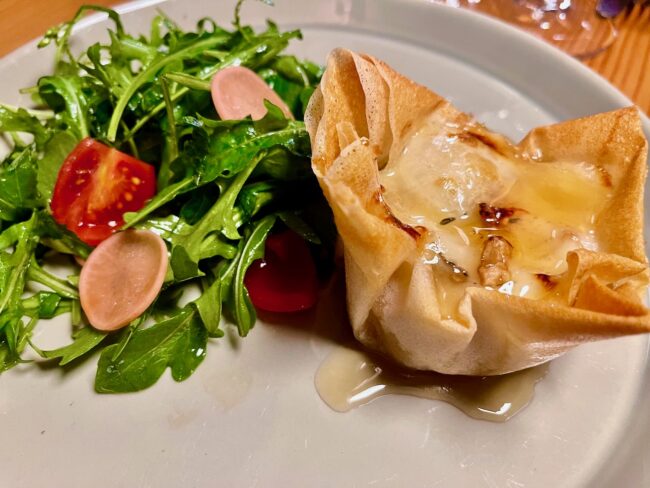
Mary’s ahi salad tasted as good as it looked.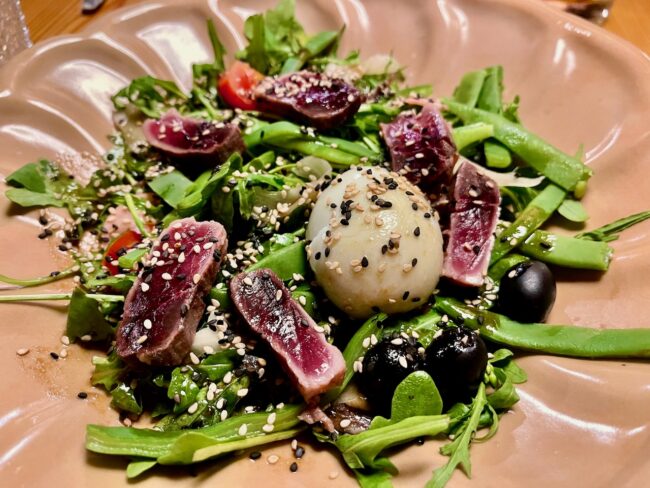
I was extremely hungry and started with steak tartare, followed by a main dish of pork cheeks.
Tracy enjoyed the roasted duck breast.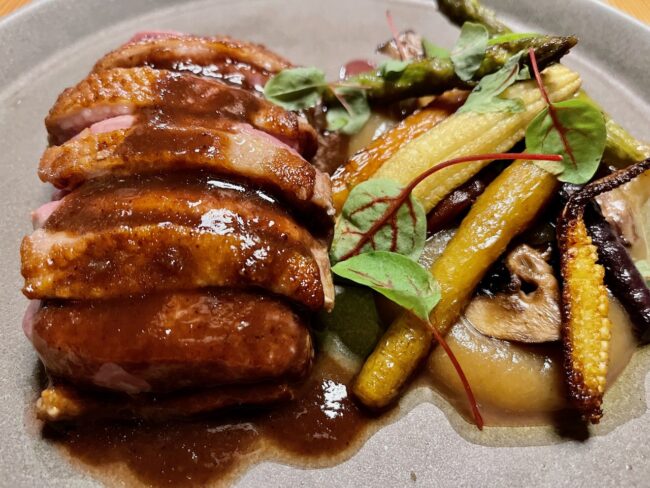
That was it for an insanely busy day in Coimbra. Not even the singing students could keep me up tonight.
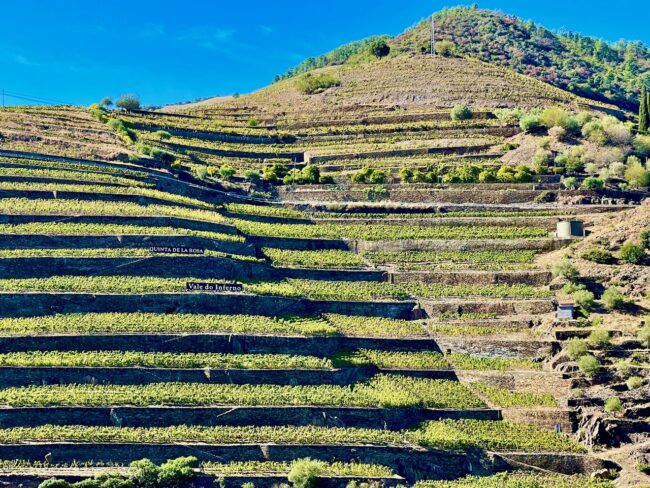 Tomorrow, we’d get our car out of storage and head for four nights in the Douro Valley. Along the way, we’d stop in the cute city of Viseu and then it was on to Lamego, where we had the choice of climbing 686 steps up to the Santuário de Nossa Senhora dos Remédios or take a peaceful drive in the woods to the church. Via a famous road we arrived in the Douro Valley at the Quinta de la Rosa (the first of our two Douro hotels), where our room had a great view of the river.
Tomorrow, we’d get our car out of storage and head for four nights in the Douro Valley. Along the way, we’d stop in the cute city of Viseu and then it was on to Lamego, where we had the choice of climbing 686 steps up to the Santuário de Nossa Senhora dos Remédios or take a peaceful drive in the woods to the church. Via a famous road we arrived in the Douro Valley at the Quinta de la Rosa (the first of our two Douro hotels), where our room had a great view of the river.
Chapter Fourteen: Driving To The Douro
Day Fourteen: A Stop In A Medieval City, Is That An Orange Julius?, Stairway To Heaven, Into The Forest I Go, Yet Another Karen Valentine Highway, “Best Drive In The World?, ”Bus Stopped, Maybe We Won’t Cross That Bridge When We Come To It, Wrong Turn and A Room With A View

